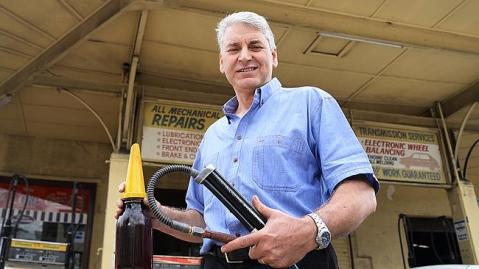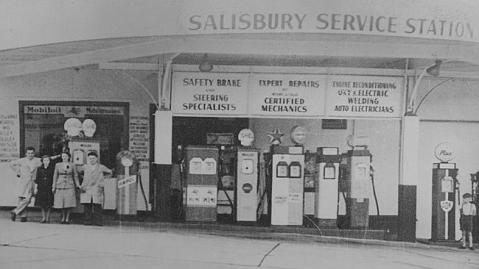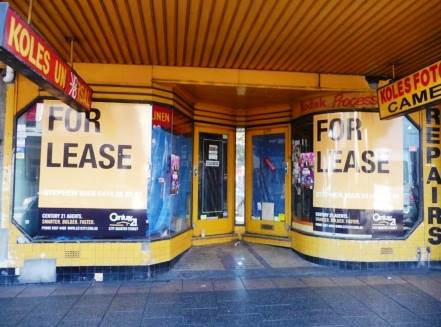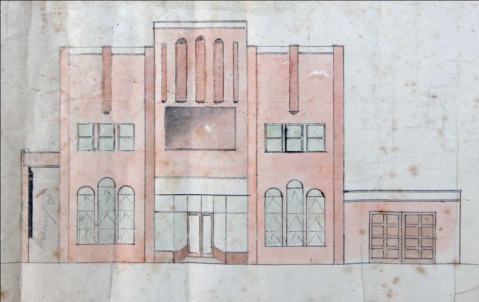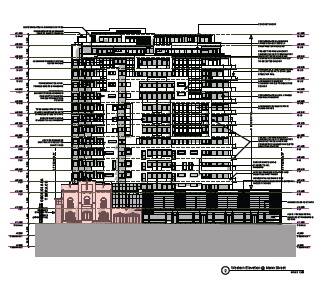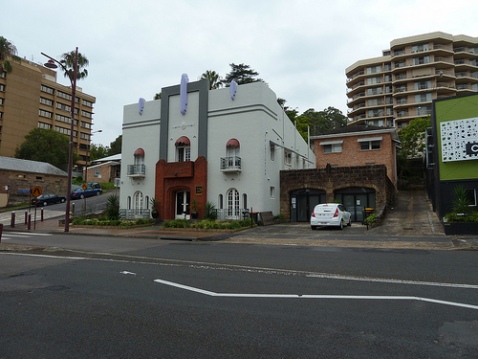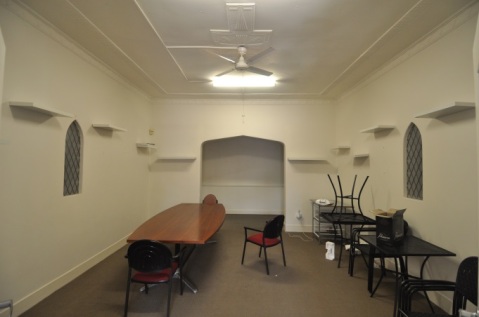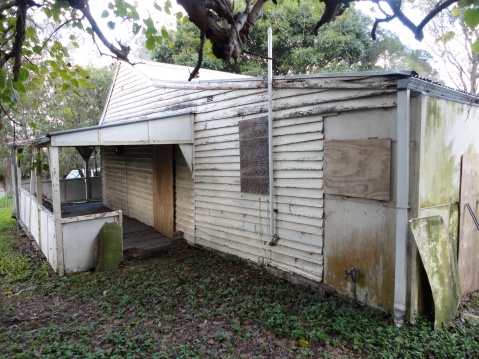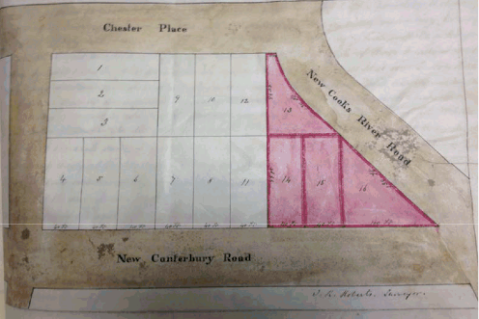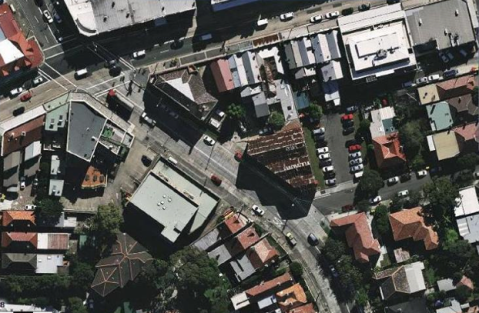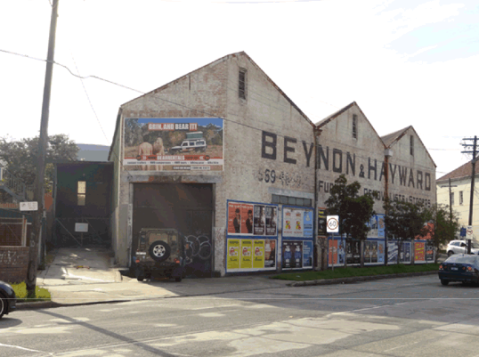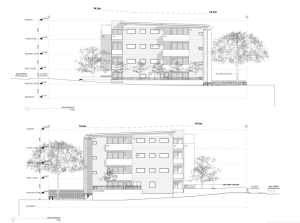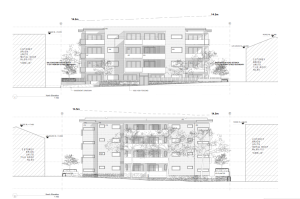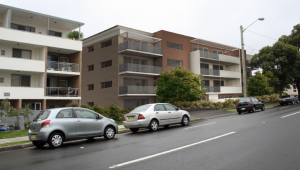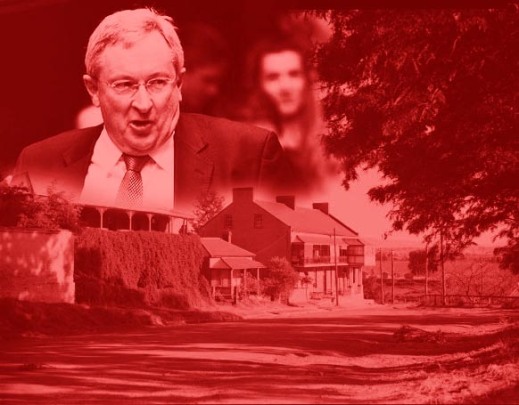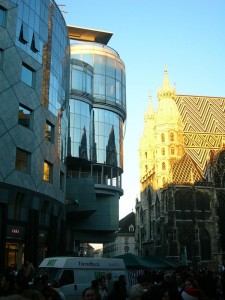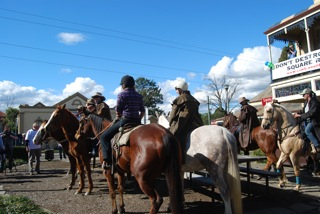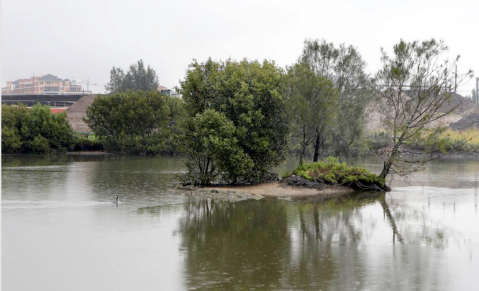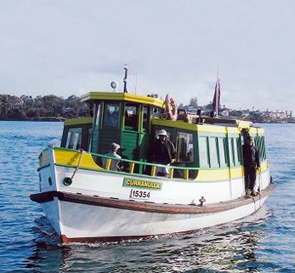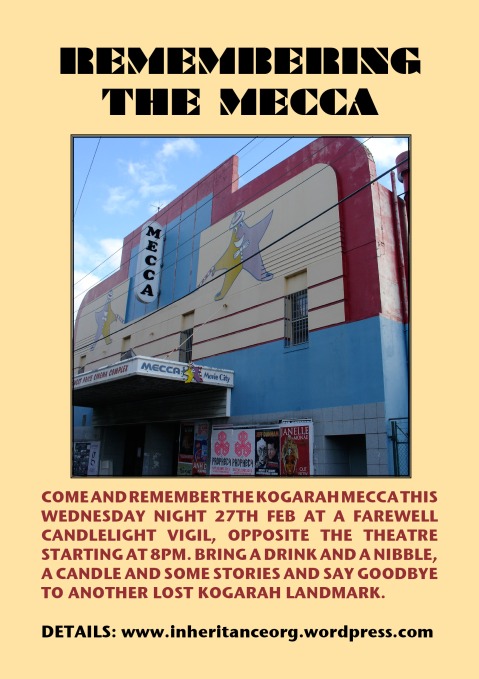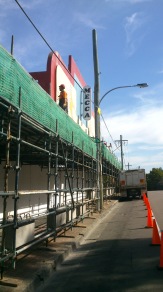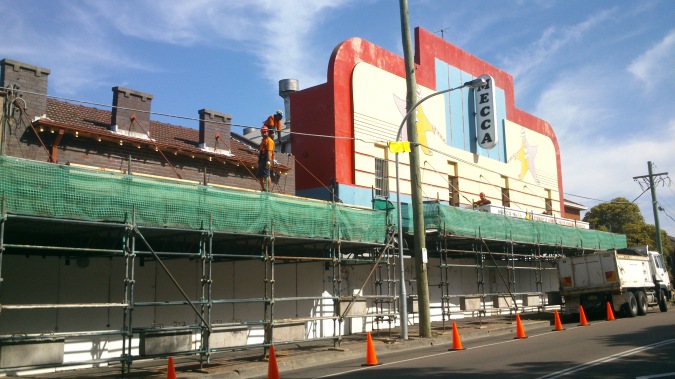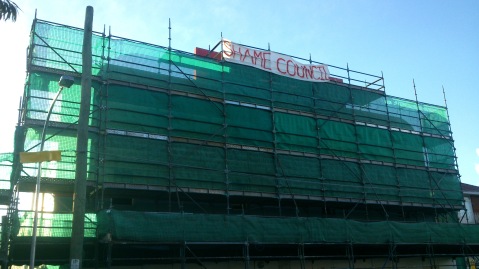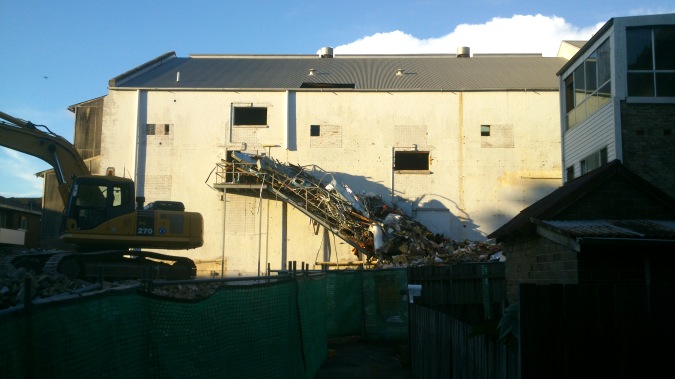HISTORIC ‘BRANDLESOME’ – A LITMUS TEST FOR COUNCIL

Truly a once in a lifetime opportunity, Bexley’s most Iconic Residence… This Federation Masterpiece is full of Period features, including High Ornate Ceilings, Wide Hallways, 4 Original Fire Places, Tiled Foyer Entry, Lead Light Windows and Main Entry, Slate Roof, Pressed Metal Ceiling and much, much more…
Not my words, the real estate agent’s… And this gracious description accompanied by bright and airy photoshoped images obviously went some way in selling the unique residence… Late in 2015 the house at 580 Forest Rd Bexley known as ‘Brandlesome’ traded at auction for $2.77 Million. It was owned by the Formby family for four generations prior, but unoccupied for many years and as a result both cocooned as a period time capsule, while also showing some signs of decay such as rising damp that inevitably result from such lack of use.
Brandlesome represents an outstanding example of Federation architecture that has rapidly disappeared from the local area. The building exhibits some fine ornate features consistent with the era, including herringbone brickwork, high chimneys and terracotta features, and those wonderful lead light windows that worked as a selling point for the real estate agent… Even rare examples of half-timber work are present, and this is not seen on many local Federation buildings.
Additionally, the very layout of the building is unique, being transversely designed, with a central front porch and large looping ‘keyhole’ arch. This is highly unusual among the regular rectangular or square shapes of Federation housing common of the time.
The fact that this house has been owned by four generations of the Formby family adds immensely to the heritage value for the local community, not to mention the original front boundary fence and the fact the house is basically complete and unaltered over the decades as many others have been.
All this would point to local heritage listing. But there is none.
Naturally a certain sense of speculation surrounded the future of Brandlesome when it was put on the market after being tightly held for so many years. But all bets were off just a short time after when a DA was presented offering complete demolition of the Federation beauty, subdivision into three land parcels and construction of three separate modern ‘superdwellings’.

580 Forest Rd. Three oversized boxes proposed to replace one heritage marvel. DA image by ZTA.

The development would be acceptable IF it didn’t involve destruction of a historic building. DA image by ZTA.
This could be seen as ‘very disappointing but very predictable’– words used by St George Historical Society president Bernie Sharah to describe the somewhat unsurprising outcome… Old house, big block of land, development biased council? We have seen it all before.
But one question still has to be asked, and that is this: Can this house be saved, and can it be saved while still making the new owner some financial gain?
The answer is Yes.
It has happened in other council areas such as Marrickville, whereby the development controls have been slightly altered to allow retention of the heritage property while adding value to the land by allowing more development in the surrounding parcel. In the case of Brandlesome, being slightly off centre on a large 2000 metre block of land, townhouses could be substituted down one side and along the back in an L-shape around the existing building, offering a better range of housing, and potentially increased profit for the developer, while most importantly retaining the heritage item.
This can be seen as a successful alternative to complete demolition, and one that offers a win-win-win situation by allowing the developer to increase their financial return, Rockdale Council to set a new standard for heritage retention mixed with quality new construction, and of course community benefit by preserving an extremely important piece of local heritage.
Far too many unique iconic houses are being lost in the area, as can be illustrated by another recent announcement that historic Halstead House in Mortdale, the oldest building in a heritage listed precinct, will be demolished in exchange for two modern dwellings. The owner says he doesn’t want to live in a heritage home, but then he should move out and leave it for somebody else. The reality is he wants to make a profit from the size of his land. And he certainly isn’t the first nor will he be the last. This will go on and on until many of our historic homes are lost.

Another St George grand home to go, Halstead House, which was removed from heritage listing in 1999. Image Fairfax Media.
And that is why we need councils such as Rockdale to act creatively, to work with developers for best results, to be strict and consistent with guidelines, and to put local heritage retention at the forefront when determining DAs. This isn’t happening at the present time, but we need it to, as the stakes are so high. Heritage only gets one chance. And houses like Brandlesome are way too precious to sacrifice for the financial gain of single owners who came in at the last minute just to turn a profit. That is no way to treat our architectural assets that mean so much to us all.
The fate of Brandlesome rests with Rockdale council. This is now a litmus test to see if a local council has the will to ensure survival of its historic buildings. The new owners have already decided to neglect their building, filling it with bags of rubbish, leaving the windows wide open and the lights on day and night. But not all is decided, and there is still time to write a letter of objection to council, or a quick email to rcc@rockdale.nsw.gov.au (quote Ref Number: DA-2016/137).
Images above by Ray White Real Estate. Title image Inheritance 2016.
A DIFFERENT KIND OF ‘GATEWAY’

What constitutes a gateway building? What does it even mean, this wildly encompassing propagandist term ‘gateway building’? Is it a building with a gateway attached or a gateway within a building? I believe it is a recent turn of phrase, coined by councils, developer lobby groups and probably the Liberal government, in order to raise the building heights to ridiculously grotesque levels on certain sites at main intersections at entry points to basically every suburb in the land. And that they do, to full extent. Oh they do love a good gateway. The bigger the better. Yep, you can’t beat a good gateway.
And while councils and developers are falling over themselves to create the next great gateway to some generic overcrowded hovel that isn’t really worth driving through in the first place, it may be time to reflect on an older school of gateway building, perhaps a different kind of gateway, built to a much more human scale than what is currently being offered up by the usual suspects who seem obsessed with leaving misguided legacies of their own Trump Towers overshadowing our once scenic suburbia.
Let’s look at Blackshaw Pavillion. Until recently, this inoffensive interwar red brick utility commanded a prime position on the corner of Forest Rd. and King Georges Rd. at the edge of Penshurst Park – a gateway of sorts to Hurstville, Penshurst and Beverly Hills. Unassuming and typically Australian in appearance, the site of the pavillion welcomed visitors to the park and the area for many decades. It was built for a former local alderman who had a love for the game of cricket, as a player’s pavilion overlooking the former oval.
Since then the oval has long gone, replaced by leaner practice grounds over the years and more recently a large aquatic centre-come-gym, which seems to be expanding and swallowing up more of the former green space every time you blink an eye. At one stage there was an old bowling club a little further into the park, but that has also been weeded out.

The former Blackshaw Pavillion, Hurstville Gallery & Museum archive

The old oval. Blackshaw Pavillion at left. Archive photo, I grew up in Mortdale 2223 FB page.
Now Blackshaw Pavillion is gone too, reduced to a pile of smouldering rubble, in the shadow of another new gateway building across the road, the massive towers sprawling along Forest Rd at the old Dominelli Ford site that appear more like a concrete fortress when approaching from the west.
Word has it that council wanted the pavilion gone due to asbestos, but the demolition was carried out without any proper removal or remediation of the site. In fact, the pile of bricks remained for a number of weeks without any covering. So what was the real reason? Well perhaps that will yet come to reveal itself. Chances are Hurstville Council just didn’t want to pay the upkeep of what it sees a redundant building. Meanwhile other councils have found ways of re-inventing disused maintenance buildings, like the very successful transformation of a pumphouse service shed in Bigge Park Liverpool which has flourished after being reborn as a trendy park café.
What is interesting or in reality more worrying is that Hurstville Council tried to demolish Blackshaw Pavilion before, a couple years ago, before meeting strong community opposition and pulling their plans at the eleventh hour. That resistance, this time, was not forthcoming. Which makes one wonder why. What has changed?
Perhaps the demographics have changed, the population that may have put in submissions against these developments in the area have either moved on or passed on. Others feel burnt out by development fatigue, no longer able to pick up the laptop and write off another submission to council for fear of fertilising their ever growing migranes or going completely and utterly mentally ill before their time. I know the feeling.
Whatever the case, the new gateways are arriving and the older, more human, more welcoming gateway buildings are disappearing or becoming just a throwback to another time. A time before councils were run as thinly disguised commercial building companies, before developer land frenzies and state government sponsored concreting booms altered our cityscapes forever. A time before ‘gateway building’ became a term, let alone a flashy catchcry to push through even more ugliness in place of sanity. I wish we could build a gateway back to building codes of past…

Hurstville’s new Gateway approaching from Forest Road.

Another new ‘gateway’ at nearby Kogarah, on the site of the RSL club. 220 apartment Veridian development.

And yet another gateway for Kogarah – ‘La Vista’, 79-83 Princes Hwy.
Title image by Tanya Jordon.
INDUSTRIAL DISEASE: DOUG UP ON BOURKE

There was a time when industrial buildings were seen as ugly, void of beauty, unsightly, uncharming. In many circles that may still be the current held point of view. I myself have stumbled over enough examples to contradict this, many of which are disappearing from our cities’ urban landscapes, as entire swathes of post-industrial precincts are rezoned quickly and easily in exchange for the current boom crop of large scale high density apartment building.
Not much ends up remaining of these monuments to our past…these warehouses, these workshops and factories, these theatres of industry where generations of workers plied their trade amongst the grit and the grime, many laboring for minimum wage, forging the products of our times, the wealth of this great nation, in a proud and honest period before we decided it was all much easier to just get things made in foreign countries and shipped over by the container load.
Indeed it appears that the bundy clock of change has swung on our entire manufacturing culture, no signs more poignant than the impending shut down of our automotive manufacturing industry, and hot on its heels the dire state of the local steel making industry. Or the textile industry, the paper milling industry, or the print industry, where even our Yellow Pages as from next year will be printed in China and shipped all the way to our shores individually shrinkwrapped to be delivered to our doorstep where most of us will faithfully pick them up and place them directly into the bin. The recycling bin at least.
I diverge, but it has become almost farcical, the whole notion of an Australian manufacturing industry. The penny will have to drop at some point, surely, when our current fortunes fade, the builders put down their tools and we realise, all of a sudden, that there really aren’t enough jobs in this country for the endless swarms of people we seem to be importing.
But all that will come… I want to talk more of what has been. To focus, perhaps, on an example of what we are trading in. A sample of building style that to our children may not be easily recognisable, as it is not, and never was, deemed important enough to keep. Both in structure and in spirit.

There is a shop, on Bourke Road, among the old warehouses, and modern residential blocks that every day seem to be mushrooming around and elbowing any lowrise competitors out of the light. In an era of mass-produced flatpack Ikea plantation particle board this place is a dinosaur, and the time has come when it has closed its doors for the last time.
The shop, a family business known as Doug up on Bourke, has traded for the last 13 years, and modeled itself as a veritable treasure trove of industrial antiques, housing anything and everything from the 1800s through the 1900s, from cast iron postal boxes to Department of Education furniture. From beaten up tin railway signs to army medical stretchers. From naval matériel to WWII navigational equipment, and from advertising articles to golden age of motoring paraphernalia. It’s all here, in spades.

Walking through the shop you get the sense of one man’s need to collect, and how it devours the soul of the needy. You can imagine the display growing from one or two ubiquitous objects on a mantelpiece into the intricate museum of what we see today. Yes, Doug was a busy boy…
And the building itself, this old brick warehouse, is a fitting tribute to the enduring purpose of industrial relics. An ideal stage for the show to unfold. With saw-tooth corrugated iron roof propped up by thick cedar beams, exposed brickwork flaking decades of hard worn paint, reinforced window slats that let in some of the light and some of the rain, as a galvanised bucket readily welcomes leaks from the ceiling.
The upper floor with its solid timber floorboards winds around and leads to a back room and stairwell down to a lower cavernous workshop. An antiquated hydraulic service lift still operates between the two levels, bringing up carpenters’ workbenches or helping to despatch metal pigeon holed filing cabinets marked SRA.
Wandering round the piles of relics, it quickly dawned on me that it is a sad indictment on our city and its people, not only to be losing a such a wonderful old world shop such as this, but also to be eliminating buildings like this from our social fabric altogether. It’s disturbing, that future generations won’t be able to walk in off the street and see places like this, in all their full post-industrial glory.
These buildings are becoming, like our manufacturing industry itself, a thing of the past. Many more like it are being torn down in a flurry, like the Porter’s Paints building next door. In fact the entire block including the massive Lawrence Dry Cleaners is earmarked for destruction. The surrounding suburbs of Waterloo and Zetland and areas like it are completely removed from what they were just a short time ago. And in order to imagine the future one need not look further than the nearby AGM Glassworks site. What is actually left of the once sprawling industrial complex? Just one chimney, a few rotten turbines and a couple of admin buildings… Or the former CSR sugar refinery at Ultimo, which had its own power station, of which nothing remains. Highrise has erased most traces of our industrial past.
These vestiges are all being torn down and wiped out one by one, in the space of a few years, denying any clues that Australia even had a manufacturing trade at all. But when the kiddies decide they want to look back in several years time and picture the kind of city their parents grew up in, they should know this: We did have a manufacturing industry once, that boomed over a series of decades, and was of world class standard. And of that we should be proud, and deem it an integral part of our heritage and social inheritance, not something that as politicians believe should be swept under the carpet, something that simply gets in the way of our current portfolio of economic retardation, that of importing people, and rushing to build canyons of concrete to file them in. What comes after that seems to be of no consequence to the current trend of government, but this also comes at the expense of the heritage of all of us; of the heritage of this great working city and great working country.
Doug Up on Bourke closed its doors on 2nd October 2015. What remained of the collection was sold off over the course of three days of gruelling auction. Doug, his daughter Sophie and son-in-law Craig have moved out and on to other ventures. Thanks for running what I consider Sydney’s most interesting shop, and goodbye.
All images Inheritance 2015.
VICTORIAN PARTY HOUSE NO MORE

Sometimes a building finds itself the source of much community affection and attachment, and at the same time these are the buildings that by their nature often help to define a suburb. One such example is Victoria House in Bexley, an old 1855 mansion that served as a wedding function centre for 65 years until its closure in late 2014, by which time it had earned the enviable status of being the longest serving reception house in Australia.
On the weekend of 25-26th July the old girl threw open her doors one last time, not as a reception centre, but as an auction house, for the purpose of clearing out virtually everything that had come to adorn the graceful building both inside and out over the course of its meaningful life as entertainment venue come antiques museum. The walls were filled with Australian art, the floors with English Oak furniture holding up Oriental porcelain and Russian Religious icons atop Persian rugs, and the ceilings hung with dazzling crystal chandeliers, one of which belonged to none other than Dame Nellie Melba in her Dandenong Ranges property.
Outside the circular gravel entranceway was studded with Mercs and Jaguars all for sale, even the garden furniture and concrete planters were tagged, and of course, leftover cases of Pinot and catering equipment galore in the vast kitchen which has obviously seen its last crème brûlée come out on a silver trolley to the hordes of welcoming guests.
But the star of the show was the old girl herself, Victoria House. Constructed by John MacLeod, a master builder from the heydey of the colony who completed such famous structures as Town Hall and Fort Denison, as well as parts of the QVB, it was a wedding present for his son Hector, a renowned builder himself who sadly died at the age of 31 as a result of a work site accident. In the early forties the house was transformed into a reception centre and run by the same family for many decades, and now, Richard White, grandson of those original managers wants to convert the structure back into a private residence once more, resurrecting the old house name of Cluny Brae.
Having grown up nearby and passed by the estate many times but never really knowing what went on inside, I saw it as an open invitation to wander around and take it all in. Up through the time-tarnished Victorian porch and into a formal landing, two vast open spaces, the Edward Room and the Colonial Room sprawl out on either side separated from each other by the cavernous catering kitchen. The Edward Room is the original grand ballroom, with sprung dance floor, intricate curved ceiling reminiscent of a church nave propped up by slender Roman columns, leading to a beautiful stained glass window behind the stage. The Colonial Room was converted in the 1960s from an original billiards room, with its magnificent wood paneled bar and great feeling of pompousness embellished with fine period furnishings. Between the two rooms simultaneous gatherings could be catered for half an hour apart.
If only these walls could talk… They would surely speak something of the endless nights of heartfelt celebration, of blushing brides, gushing parents and boozy heads… It is easy to see that Victoria House is still revered, many of the people filing through spoke fondly of having their wedding receptions take place within its walls decades ago. I even overheard two young girls talking of when they worked here, not so long ago, and chatted to a former MC of the house who was taking one final look.
I turned and said how sad I thought it was that all this was coming to an end. “Not really”, he replied, “all good things have to come to an end…” and I reflected on it later – that wasn’t a throwaway comment, he was absolutely right. All good things do come to an end, and perhaps that is where we should leave them, rather than pine after them in some dimly lit memory for years and years to come.
For so many people this grand old building held a special place, and over this weekend in July 2015, she still knew how to turn it all on one last time.
EPILOGUE: Elsewhere in Bexley…
Just up the road from Victoria House, the Federation masterpiece known as Brandlesome, at No.580 Forest Rd. has recently traded hands after being neglected and unoccupied for many, many years. We hope the building’s heritage status will ensure it remains an asset to the area for generations to come (although knowing Rockdale council it may be surrounded by townhouses by the end of the year).
And down the road, another local icon has closed its doors for the very last time. Bexley Jewellers has ceased trading after 46 years. I remember this shop as a child and recently went in to find smiling owners Mona and Raymond Awad still tending the business of jewellery and watch repairs as they had done for decades. This really was an old school suburban jewellery store in the finest sense of the word. Mona and Ray will be missed.
Brandlesome photos Ray White, all other photos Inheritance 2015.
KOGARAH RESIDENTS FACE THE ENEMIES WITHIN THE GATES

More than 200 men, women, and children packed the Kogarah School of Arts today to talk about the proposed LEP changes soon to be passed by Kogarah Council. Over the course of nearly two hours they heard from speakers including young gun MP for Kogarah Chris Minns, local residents and members of Kogarah.org, an umbrella group formed to address the shortcomings associated with the LEP and educate more people into standing up against unwanted overdevelopment within their area.
Clearly the proposed LEP for Kogarah is all about overdevelopment, and badly planned overdevelopment at that… Issues such as 21m (7 stories) height limits nowhere near railway corridors, highrise up to 39m all through the shopping and business precincts, density increases along the already congested Princes Highway and Rocky Point Rd. among others, removal of waterfront buffers, and total lack of consultation and transparency by Kogarah Council has forced these people to come together and fight what they see as an indignity being wrought upon their suburban lifestyle by the very ones in power who were elected to represent the residents interests, not walk all over them.
No Kogarah councillors chose to be present.
The fact Kogarah Council has not included a biodiversity study seems grounds to make the LEP invalid, said one speaker, a former lawyer with the Land and Environment Court. Not only illegal but also a bold statement by a reckless council who chooses to flaunt the rules in their arrogant push to quickly and quietly steamroll this bloated LEP through while the doors are wide open.

Member for Kogarah Chris Minns voices his concern over the LEP. When even a state MP says it is an overdevelopment then you know something is not right.
I think there is a moment in time when it becomes blindingly clear that the ones we are meant to trust to do the right things for us we can no longer trust, and this moment is now for Kogarah.
Perhaps it underpins a broader social problem nowadays, when even the local council can’t be trusted to bring the best results for its residents, then who can we believe in? Are we at that point where municipal pride has not only flickered away like some 1900s candle, but been highjacked by the deeds of wayward councillors who have clearly forgotten their role in the community, the reason for their position, the pride in their own job?
That lack of public confidence translates into somewhat of a breakdown in society, or at least in society’s values. Is it too much, after all, to expect that our cities and our suburbs, our streets and our schools, won’t be stretched to breaking point by the unwanted development we now find ourselves being repeatedly jabbed with, forcing residents to either scatter like rats or come together in bands to try and salvage what we can of what we see as our right to control our own destiny.
Well today, in Kogarah, the people didn’t scatter… They came in silently, queued on the stairs contently, and crammed the little School of Arts to physically demonstrate their opposition to a flawed and greedy piece of legislation which would only bring gains to council, government and those set to benefit financially from the mass rezoning of land parcels. The average resident can only lose here. And so their voices were heard, in numbers…
I would like to congratulate those involved with Kogarah.org, and all those who took time from their Sunday afternoon to come out and fight for their suburb, to fight against the greed and insanity of this overdevelopment. To fight to have a voice in what happens to their environment, their surroundings, to fight for what happens all around them, for their community. Yes, we all still have a community and it appears nowadays we do have to fight for it. It just seems a shame that the ones we are fighting are the very people we chose to represent us in the first place.
Check the Kogarah.org website here for the facts. Get submissions to Council by Friday May 29.
ART DECO EMBRACE

I recently had the privilege of rummaging through an old Art Deco cottage that had been sold at auction as the result of becoming a deceased estate. While the house was traded for an inconceivable amount, purely due to its land value alone, and will inevitably be bulldozed in the longer term, what I found inside was a veritable time capsule of that era, one that still retained many of the original installation furnishings and fixtures, including doors, light and bathroom fittings, masonry and tilework, even what were probably the original carpets and mattresses still in good condition.
To stand the test of time for so many decades, to remain usable even to this day, and to repel the heavy wear and tear that a house and all its surfaces must endure on an unrelenting basis, demonstrates just how fine a quality of finish the Art Deco suburban home was adorned with…
Bank vault doors still kept guard with heavy chromed handles. Magenta heirloom rosebuds looked up from vibrant carpets underfoot while emerald ivy climbed the halls across sheets of crisp wallpaper. Frosted spectacular triangle shapes pierced the windows like leadlight icicles. Jade ornaments bedazzled the bathroom between geometrical tiles like carved Maori offerings. Organic flying saucers filled the corners of the rooms with their soft yellow glow while an original Smiths Sectric Durban clock kept time upon the wall as it had done for decades.
As I took it all in I could only stand in awe at the level of workmanship and decoration that was crafted into these dwellings of the period, and was left pondering the question “why are we knocking down so many of these wonderful and graceful buildings only to replace them with cheaply built and unremarkable alternatives?” The answer still makes me feel dumb.
Inside the house there was an air of regality that I knew now could not endure, not with new owners, not in this day and age… The former owner, over 90 years old, saw no reason to change things. The new owner –any new owner– nowadays, will want to put their own stamp on their possession and customise things to their liking, breaking the entire synergy of the long held original.
As a result I noticed the old carpets were ripped up and placed out onto the footpath on first inspection. Not that I have any right to criticize that, not everybody wants 80 year old carpets in their living room… What I can rightfully lament though is the fact the house has definitely now lost a sense of originality and completeness; The time capsule, if you like, has had its lid torn open and its contents strewn out into the hard light of day. Nothing will be the same any more, not in this house, not in many more like it…
All pictures Inheritance 2014.
DISAPPEARING SYDNEY

Sydney is disappearing… The city we know and love is being lost before our very eyes, sold off and torn apart, opened up and ripped into pieces.
Inheritance the blog was created to document this change and show some of the things we are losing across our city and our state. Inheritance Society and NSW Heritage Network were incorporated to allow like-minded individuals to come together and share their collective views and work towards turning the tide around.
Disappearing Sydney has now been created as a Facebook group to share photos and alert people visually to the loss throughout their own areas.
If you have a camera or a smart phone, you can be part of this group and make a contribution simply by uploading your own photos of buildings and places that are disappearing, sharing them with a wider audience.
It is not fair nor right that our city is being treated this way. Much of the high-rise development that is being pushed by local and state governments is a direct result of offshore foreign investment. Our state government in particular are willingly selling off prime assets and promoting NSW as being ‘open for business’, indulging in high density building frenzies and population growth spurts just so they can stand tall at the next election and claim how viable the economy has become.
But we have our eyes open. We are weary of the fact that they have become addicted to excessive residential building as a tool for injecting large scales of money quickly into the economy. We are aware that they have created an artificial housing boom by promoting foreign investment into exclusively new building projects, a boom that has left many of our next generation of Australians wondering how they will ever be able to afford their own piece of the pie.
We are aware they have watered down heritage and environmental laws to allow full exploitation of real estate potential across the state. And we are aware that our society and our lifestyles are being irreversibly altered and constantly threatened by this excessive race to grow the economy at all costs, in the most aggressive way possible, not by creating new industries and fostering smart technologies, but rather by simply injecting more people and pushing more concrete into the sky.
Indeed we have witnessed the shameless selling out of future generations. Rather than growing to become part of society and working towards a common goal of home ownership, many are left scratching their heads and saying “how will I ever own my own home?”
So much of our heritage is being lost to the building boom and we are constantly watching priceless treasures disappear forever, denying future generations a sense of place and perhaps a sense of understanding of our cultural identity – the visual links of layers of architecture laid down over decades.
All this disappears every time a developer decides to buy up in an area and flaunt lax heritage laws by bulldozing everything within site. Like great trees in the forest that have taken many years to grow and only a brief minute to cut down, so too are our heritage assets so carelessly sacrificed. And what remains is merely a testament to the greed of rapid economic expansion at any cost. What we are left with is an altered sense of culture and identity, a collective mindset that is severed , one that has difficulty reconciling the place of its own heritage in a rapidly changing world. What governments often try to make people forget is that all of this is also completely unsustainable within the context of life on this planet over the coming decades.
Heritage is important… Tangible evidence that people were here before us, often doing the things we do, living their lives, building our society to what it is today. For us to turn our backs on all that and simply bulldoze everything in sight for the quick growth of economy is unjustifiable. Inheritance and Disappearing Sydney seek to address these issues that confront us, not just for now but for generations to follow, because we want to endow these generations with the same chance of discovery that we have had ourselves. We want the cycle to continue. And we want them to be identified and feel a sense of belonging. For without our heritage we certainly are nobody…
THE WORD ‘DUMB’ SPRINGS TO MIND

What is the next worse thing to losing a heritage building? Seeing it altered to the point it is barely recognizable as a heritage building…
I’ve always admired this Auto Electrical workshop at 3 West St. South Hurstville. And every time I drove by recently I was almost expecting the worst (some of you heritage die-hards would know the feeling)… So I cringe to think who could go out of their way to try and ‘modernize’ such a classic and unique piece of Australian automobilia heritage, just as this type of genre is coming back into rage.
I ignorantly assumed the building was locally-listed (or it would have been gone already by now), but have since been informed otherwise by Kogarah council. So I guess I should be thankful it still holds its place at the top of the hill… However it confuses and astounds me that the owners would choose to remove the fixed awnings, the workshop doors, the advertising signs and street lettering, and alter the colours to some ugly non-relatable paint scheme – almost everything that made it an automotive workshop in the first place is gone.
Now instead it looks like some disused army barracks trying hopelessly to resemble a modern office space. What a total failure on two counts – the obvious and clear willful neglect of heritage attributes, and the badly attempted rebirth imitation of a building into something it is clearly not.
More on the mark would’ve been an outcome that reflected the original features of the workshop. A café would work, a showroom of sorts, retail, (an auto electrician would you believe?), anything really that pays homage to the structure and heritage of the site. It’s a simple recipe that we fail to abide by time and time again. Normally the excuse is the overruling ‘need’ for highrise but that is not the case here, this is just plain dumb.
So, we still have the heritage building, but what is missing here? Everything that makes it a heritage building, more or less.
Again we have failed to give a rare heritage asset the protection it deserves. In effect an example illustrating in vivid red why we need heritage listings and rules to abide by regarding the presentation of heritage buildings. Instead we have a classic and rare shopfront that has been unceremoniously bastardized and probably won’t exist for much longer in any case. And a couple of key adjectives that go some way to describe this kind of behaviour – the words ‘dumb’ and ‘dumber’ spring to mind…
LIFE AND DEATH OF THE FULL SERVICE STATION

If you are a lover of Art Deco as am I, you may be slightly miffed by the loss of one of Sydney’s only remaining original 1930s full service stations. If you have been swayed by the Petrolmania craze that has taken over our televisions you may be a little saddened by the closure of one of the last purveyors of oil from glass bottles and classic automobile nostalgia. And if you are simply a fan of good old-fashioned driveway service you may just miss the welcoming sight of the Salisbury Service Station at Stanmore for it is about to be wiped from our motoring maps and minds forever.
You certainly won’t miss the rising concrete frame of yet another block of boutique apartments with an overzealous moniker, this time known as ‘The Radius’, perhaps as some kind of bizarre lip service homage to the semi-circular floorplan of the Art Deco structure it is destroying.
The family-run business is set to shut up shop and leave the Percival Road location it has graced since 1930, having being sold to a developer who will make full use of the prime inner west location and valuable crossroads pocket of land.
Current owner Norm Iacono doesn’t seem to be all too upset with the outcome. He took over the reigns from his grandfather in 1997, ran the shop for several years and is now happy to be moving the business to Summer Hill while selling the Stanmore site for a king’s ransom. Pointing the blame at higher running costs due to petrol storage laws, his comments to media that “A lot of people come in and say what a great building it is, but the building was built in the 1930s, so there is no real significance for architecture” initially struck me as slightly odd for a small business owner who has traded not only in petrol but also nostalgia for so many years. After all, you don’t see too many Art Deco service stations from the golden era in such original unchanged working order. But when you consider he is set to benefit financially by the full demolition of the site you can see how quickly nostalgia is pushed to the side like some old rattle gun that has come to the end of its useful life.
Norm is hopeful however that the developer will pay some sort of tribute to the heritage of the site, by displaying the oil bar near the entrance to the restaurant or something to that effect… It could have a Model T Ford parked in the foyer for all I care, it will still be just another oversized concrete box with a Model T parked in its foyer. There is simply no substitute for the original item.
It would have been nice to retain at least the drive-through frontage part of the structure and re-purpose that as an outdoor cafe – I mean, we are talking a matter of a few square metres for pity’s sake, would it be so hard to retain at least that much heritage within the total area of the site?
Unfortunately this buy-up of prime service station sites across Sydney is not confined to just this fine example. It is happening all over and many old independent stations are being bought and converted into apartments as developers fight to get hold of these prime main arterial slices of land. Among others, another Art Deco workshop at Princes Highway Tempe recently closed and is slated for residential redevelopment.
And sadly the lack of understanding and protection of Art Deco is not limited merely to the destruction of petrol stations. Retail shopfronts of the era are also making way for the modern. This one in particular at Liverpool Rd. Ashfield, a beautiful example of 1930s expression, is set to go. A DA for the total removal of the Koles Foto/Manchester shopfront was approved in August by Ashfield Council who don’t seem to appreciate the beauty of their own area enough to respect its architectural merits. What will rise in its place will undoubtedly not share the same level of pizazz this shopfront exudes. Sad times indeed for fanciers of Art Deco and Sydney heritage moreover…
Main title image Daily Telegraph.
URGENT: GOSFORD FUNERAL PARLOUR FACES ITS OWN MORTALITY
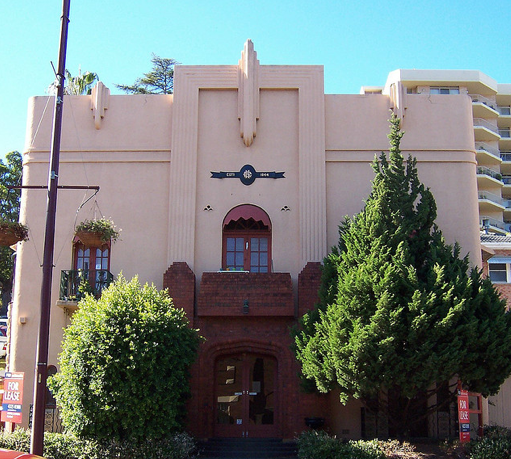
A stunning heritage-listed funeral parlour near the waterfront in Gosford that has ushered out the lives of many local identities is itself facing the possibility of an untimely end. Creighton’s Funeral Parlour at 37 Mann Street was built in 1938 in the Art Deco style by architect F. Vanderwyck Snr. The Creighton’s family business was known in the area since 1844 and was involved in building and demolition work before becoming funeral directors in 1872. Six generations of the Creighton family practiced locally under the business name.
The building is treasured not only because of its association with the well renowned family, but because it is such a marvelous and rare example of an Art Deco purpose-built funeral parlour.
Externally, a grand central arch surrounded by decorative red brickwork heralds the main entrance. This is flanked on either side by secondary arches with quality timber framed lead glazed windows, and the theme is continued on the upper floor with a trio of balconettes showing ornate cast iron balustrades, and three magnificent streamlined parapets at roof level surging into the sky. Decorative balustrades also surround the lower windows. The construction is of textured cement rendered brick, comprising two stories at Mann Street, sloping back steeply to become one storey at the rear.
On the Georgiana Terrace side (left hand, facing) is an enclosed balcony made of locally quarried rock-faced ashlar sandstone while on the opposite wing is a sandstone garage consisting of twin Tudor arches and matching parapet. Behind the garage doors are open concrete pits to allow access for working on the funeral hearses. This has been currently re-purposed as a cocktail bar, showing clever use of a heritage asset. Rather interestingly, the roofline on the Georgiana Terrace side is scalloped while the garage side is straight-lined.
Internally, a central porch leads to the house chapel that extends below street level and is surrounded by small offices. An interesting feature are the backlit frosted glass windows obviously created due to a lack of natural light filtering into the room. Original drawings for the floorplans show that very little has been changed since 1938.
The parlour is located right in the middle of an identified heritage precinct containing several unique buildings, some of which the Creighton family were involved in constructing, including the heritage-listed 1929 former School of Arts directly opposite. According to the Australian Govt. heritage database:
‘The site is located on the main street of Gosford within a precinct of civic and commercial buildings, including Gosford Council Administration Building, the Sydney Electricity building, the Old Gosford Court House and Police Station (now a branch of the Conservatorium of Music), the School of Arts building, the Post Office, Gosford Public School and several churches including a small sandstone church designed by Blacket. This precinct is located near Gosford Wharf which served as the main transport link to the area before the railway was opened in 1887. With the opening of Gosford Railway Station, the main commercial area re-established itself about 0.5km to the north in close proximity to the station, leaving the earlier civic buildings in a group near the wharf.’
Such a beautiful, rare and significant local building that has indeed been heritage-listed because of its qualities should never come under threat. However current owners Zenith have submitted a DA to turn it into a 15 storey skyscraper with 4.51:1 floor space ratio while only retaining the façade of the original Creighton’s funeral parlour, completely overwhelming any heritage reference to the site while destroying the interiors and the structural make up of the building.
This outcome is simply unacceptable. While the developers will claim they are retaining the façade, the fact is they are destroying the heritage of the building and simply paying lip service to what has stood there and served the people of Gosford since the pre-WW2 era. There is no way that sticking a façade onto the end of a 127 apartment vertical glass monster is any substitute for the genuine heritage this site commands. What’s more is that the façade of the parlour will not be able to be left standing in situ while excavation takes place all around it. Rather, it will be deconstructed and pasted back together as an afterthought using new artificially aged and recycled materials, meaning the original fabric of even the façade will be completely falsified.
While we may not be able to stop unsightly highrise development from infecting waterfront areas up and down the eastern seaboard of Australia, we certainly should be able to stop the wanton destruction of locally listed heritage assets such as this one. The DA, being rushed through council currently, only allows comments until 24 September. The controversial rezoning of the site to a 36m height limit by council has opened the door for this kind of overdevelopment. I strongly urge people to use the link on the council website to oppose the demolition of this building in any shape or form by clicking here. Even a simple comment is helpful.
Remember, September 24 is the cut-off date. Save local history Gosford City Council, do not even think about sacrificing this very unique heritage treasure. A façade is not heritage. It is only a glimpse of what was once there…
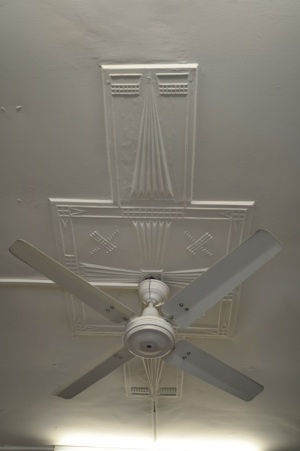
Internal chapel ceiling plaster detail. All this would be lost under the DA. Image Rappoport Pty Ltd.
‘GUNYAH’ STILL UNDER A THREATENING CLOUD

Having endured in recent times an allegedly corrupt mayor, excessive developer-biased rezoning and a rapid changing of the character of their suburbs, Sutherland Shire residents now face the very real prospect of losing their oldest building, thanks to an errant council who seem determined to dig up, sell off and knock down as much as they possibly can during their time in the sun…
Sutherland Shire Council seems intent on pushing through its draft LEP, which will not only raise the building densities of many of the beachside suburbs, but also seeks to remove its oldest house from the heritage list. The worker’s cottage, at 5 Evelyn Street North, known as ‘Gunyah’, dates from c.1870 and formed part of the vast Thomas Holt Sutherland Estate. It is in fact the only remaining physical link to the estate and widely recognised as the oldest house standing in the Shire.
All this hasn’t stopped council from seeking to de-list the building, claiming restoration costs as being prohibitive. But there are a few fishy smells coming from Sutherland Shire’s reckless decision making… remembering council actually owns the site, and has let the building slip into disrepair over a period of more than a decade through total lack of maintenance.
And also remembering that the entire draft LEP springs from the troubled tenure of former mayor Kent Johns, who resigned both his mayorship and pre-selection for the state seat of Miranda in disgrace after allegations of corruption following his famous last-minute Mayoral minute, these are all reasons for concern. He remains on council, and many of his Liberal colleagues are still running the show, such as Cr Kevin Schreiber.
And the fact that this decision contradicts advice from not only council staff, but also the State Government independent review panel means councillors intend acting without any given mandate, neither from the public, nor state government, nor even their own council officers. This simply defies logic.
By de-listing the house they stand to now make a massive profit by on-selling the land as a greenfield development site. Perhaps rezoning is on the cards, as has occurred directly across the road where townhouse-units are now being built. The property minus the cottage would be worth a pretty penny (reportedly up to $1.8 million), considering its proximity to the shoreline and desirability of location.
Cr Kevin Schreiber, a Liberal councilor who served as deputy mayor 2012-13 next to Johns, told Fairfax “As much as we like to keep our heritage sites, … the cost far outweighs the benefit to the community.” But we can take what he says with a little grain of salt. Schreiber himself was referred to ICAC for questionable development approvals and political donations back in 2008, along with three other Liberal councillors including our friend Kent Johns.
Schreiber and Johns denied the claims, which related to 30 non-compliant approvals within two years, but all the councillors were de-listed from the Liberal party at the time and forced to register as Indepedents. That makes three times since 2002 by my reckoning Kent Johns has been involved in ICAC referrals, and yet this character remains a B ward councillor in the Shire still making planning decisions. Is there any wonder the LEP has turned out like it has?

Two peas in a pod, councillors Johns and Schreiber, both part of the Liberal team, both with corruption allegations against their names. Image Fairfax Media.
Current deputy mayor Tom Croucher, another member of the Liberal dream team, claims the council can’t afford restoration. “The council has no funds to restore it. I ask it be removed from the heritage list,” he said. Simple as that…
Okay let’s assume that to be true. That they can’t afford it. It may well be… So what gives them the right to de-list the building as a heritage item? Just because they can’t afford to fix it? It makes no sense to me at all, am I missing something here? If you or I own a heritage-listed house, and we decide we can’t afford to renovate it, does it then get de-listed, and sold to the highest bidder as a development site? Is that how it works? I really don’t think so. I could be wrong, but I didn’t think it worked that way. If it did there wouldn’t be many heritage listed homes left.
The clear and logical solution for Sutherland Shire Council is, if they really can’t afford to renovate the cottage – this asset to the people of the area, this visual link to early European settlement – then don’t. Sell it as a heritage listed item for somebody else to renovate, or lease it as a museum for people to enjoy. Don’t destroy the very local heritage you are meant to protect just to turn a bigger land sale profit, that is not the right thing to do. It may sound clichéd but once it is gone, it is gone for good, there is no bringing it back. And buildings of this vintage, in this locale, with heritage links to our founding forefathers, are already few and far between.
I implore people, residents and non-residents alike, to contact Sutherland Council, and ask that they not go ahead with de-listing and demolishing this important cultural asset as it would be an irreversible loss to a community so closely tied with the early European settlement and growth of Australia.
Email Sutherland council ssc@ssc.nsw.gov.au
The safety fence has already gone up around the house, this is not a false alarm.
OUR SECOND BIRTHDAY & HERITAGE BRIEF AUGUST 2014

Well, time flies and we’ve already notched up two years within the blogosphere here on these pages of Inheritance…
It seems just about ripe for a format change too, as it becomes increasingly difficult to keep up with the state of heritage loss currently being enacted all around us… time constraints, life getting in the way, etc. etc. and more openly it’s getting a little monotonous writing the same old story that generally reads something like this: “beautiful building neglected, beautiful building acquired by developer, developer knocks down beautiful building, ugly big building rises where beautiful building once stood…”
I had thought we would be learning collective lessons by now and while I believe the general public may be cottoning on ever so slowly, single-minded politicians and the development lobby still hold the trump cards and aren’t afraid to use them to keep the current wave of urban renewal riding off strongly into the sunset. Meanwhile residents are held to ransom and left to watch in horror as wonderful heritage assets are systematically stripped from their neighbourhoods wherever the wrecking ball of developers decides it wants to swing.
So now we will take a more general overview of current heritage issues, in order to cover more ground more succinctly and keep updating while still maintaining the original focus of publicizing heritage neglect and destruction that keeps people like me in business and gives us something to do with all our otherwise misguided energies…
Heritage Brief August 2014
Art Deco waste in Chatswood
Another day, another demolition… This time it will be a beautiful art deco block of units at 745 Pacific Highway, Chatswood which sold in late 2013 for a reported $3.5 million and will be replaced by, you guessed it, another modern block of shop-top apartments reaching five stories in height and no doubt maximising real estate value of the highway frontage by leaning right over the footpath and every border of the property.
A shame to see the beautiful stylised brickwork of this building and symmetrical forms sacrificed for more faceless monolithic residential stock. No building that replaces it will ever have the same level of workmanship or quality of design that this art deco wonder had, that much I can guarantee. So it’s overdevelopment 1: heritage nil.
If anyone is local and handy with a screwdriver I would suggest going over and salvaging this beautiful set of art deco doors from the jaws of the bulldozers. The owners obviously don’t care and shame on council for not making removal of doors and fittings part of the deal.
Ramsgate shops lost
Not much was left of this charming row of Federation shops along Rocky Point Road in Ramsgate. A real estate agent in a shopfront to one side had originally opposed the DA (surprisingly), and for some time their little corner of the site was left standing. Now they too have decided it was a better option to get out, leaving nothing behind of the heritage architecture but a gaping hole in the ground soon to be filled with more units that actually rise above what the local DCP allows for by a massive two stories. With Rockdale council controlling one side of Rocky Point Rd. and Kogarah Council the other, it seems both parties have engaged in a race to decide who can ruin their side of the street the quickest. (For more info read here). Overdevelopment 2: heritage nil.
Princes Hwy, Highway to Hell
Further along at Princes Highway Rockdale, the story emerged of an elderly couple who decided they didn’t want to sell their family home of 60 years, when a massive eight storey development took shape next door. Instead of bowing to the pressure by developers, Barry and Betty Dickson decided to stay put, and after several months of jack hammering and earth moving going on just over the fence, health effects are starting to take their toll on the resolute couple… perhaps they regret not moving after all.
But then again, “you show me where there’s a house on a corner block with room to park five vehicles close to the hospital and with a shed” said Barry to Fairfax reporters. Let’s hope he can continue to live the way he wants to, without too much bad karma from the ruthless encroachment of land grabbing all around. Overdevelopment 3: heritage nil.
Nearby on the corner of the rapidly changing Gray St, an old converted Federation doctor’s surgery is about to make way for ever more units. This street is also home to the yet to be opened new Emergency Department of St. George Hospital, and every house opposite (currently old cottages) is on the chopping block. Quite an interesting planning strategy, putting a new ambulance thoroughfare on one side and multiple blocks of units on the other, considering the street is already gridlocked during peak hours. I hope nobody I know will be waiting for an ambulance once this is completed, it may be a nervouse wait… Overdevelopment 4: heritage nil.
Kogarah is gone…
Expect to see much more desecration around Kogarah. At the council meeting of July 29, the motion to send the new ‘Kogarah Housing Strategy 2031’ to the NSW Department of Planning to go on exhibition, was won by 10 votes to 1. One councillor, Lachlan Mclean, who prides himself on not supporting overdevelopment, made these comments against the motion:
The proposal is an extreme overdevelopment of North Ward and I refer to 3 key examples that will anger residents and ultimately detract from our lifestyle:
1) The change to allow buildings of up to 11 storeys or 33 metres in peaceful residential streets such as Palmerston Street, Victor Street, Victoria Street and Stanley Street.
2) The change to allow buildings of 39 metres on Railway Parade backing onto Bellevue Street and the Kogarah South Heritage Conservation Area.
3) The change to allow buildings of 21 metres or up to 7 levels on the Princes Highway backing on to John Street in Kogarah Bay and Wyuna Street in Beverley Park.
…Some will say, let the proposal go to the Department and then let the residents have their say. It doesn’t take a genius to figure out that so many North Ward residents will be outraged by these changes and I don’t want to put them through the stress of having to justify why 11, 12 or 13 storeys shouldn’t happen next door to them.
…This proposal doesn’t strike the right balance and won’t provide residents with a better lifestyle. It is all very well to speak about the needs of future generations, but there is no evidence that the necessary infrastructure will be in place to support these changes – our roads will be gridlocked and will struggle to cope with future population growth.
Wise words indeed from the North Ward councillor. Yet his thoughts are clearly in the minority on this council. Kogarah, unfortunately, like many other suburbs, has NO chance of a sensible planning strategy now. Well done Lachlan for rejecting the draft. Shame on you, Kogarah Council, for burying your ratepayers in high rise, many of whom, wouldn’t even see it coming.
Sports Club calls last drinks
South Hurstville Sports Club has become the latest casualty in the shrinking world of bowling clubs closing its doors after 57 years of service. The struggling club called for last drinks on Saturday June 28 as they move to amalgamate with nearby Peakhurst Bowling Club. The classic Art Deco building is owned by the Catholic Education Office, and we strongly hope the owners will be able to repurpose the wonderful architecture, however no plans have been announced for the site. I will be personally contacting the Catholic Education Office to suggest this.
This news comes on the back of the St George Bowling Club at Rockdale being completely demolished by council after arsonists caused damage to the roof structure. This was a superb piece of architecture on a prime ‘development site’ and it appears Rockdale council have done nothing to save it. (For more info read here).
It never ceases to astonish me that every time a club like this closes, more isn’t done to protect the site from private development. The local population are losing amenity, a place to congregate, a place to mingle, to socialise, and to gather… When that former social space becomes a closed door development, the whole community loses out, especially the elderly.
Kyle Bay’s future outlook
Nearby at picturesque Kyle Bay, residents are fighting to keep their leafy bay ‘leafy’, after a hushed rezoning push-through and development has been proposed for the 24,000 square metre Kyle Williams estate. The privately-owned bushland site that currently occupies much of the expensive hillside is much loved by locals who fear the loss of natural amenity. Indeed this is one of the last natural areas of remaining bushland so close to the mouth of Georges River.
The land was bequeathed by Caroline Milne Williams who ran a respite home for convalescing children until her death in 1939. Currently the heritage-listed Legacy House continues that tradition on site, however the Greek church-affiliated Estia Foundation is proposing a massive and potentially uncapped expansion via the rezoning. More than 200 objections have been sent to council.
For those who water down concerns of residents stating they only want to hold on to their million dollar views, well, wouldn’t you? If you invested into a house and suburb with a certain natural outlook, and all of a sudden that outlook is threatened, and the prospect of watching new development rise up becomes a reality, then why wouldn’t you complain… Amenity of the estate is not the issue here, it is suitability of the site. Overdevelopment 5: heritage nil.
Outside Sydney
Gosford council recently looked at a motion to rename Brisbane Water and the Broadwater ‘Mariners Cove’, however the motion was defeated after observers including our own NSW Heritage Network scrutinized the renaming in connection to the Central Coast Mariners football club, of which Gosford City Council is an official major partner. And rightfully so – if renaming of geographic sites starts here, where will it end – ‘Bluetongue Bay’ or ‘The Coffee Club Ranges’…?
In Eden, the case of Hotel Australasia has gone before the Land and Environmental Court recently as a Section 34 mediation, as the developer Great Southern Developments tries to sell the merits of a third supermarket in a town that doesn’t really need it, on the site of the historic and characteristic local pub. The result as it now stands will see the hotel completely demolished.
The developer had indicated they would spare the 1951 front skin of the building while seeking financial compensation of $460,000 for lost rental space as a result of retaining the facade, but council decided this was too much to pay, leaving concerned residents and local heritage with nowhere to stand. Hotel Australasia has long been described as the ‘heart and soul’ of Eden, now the township will have to survive without it.
This is what happens when mediocre councils shy away from heritage listing in the first instance – you lose old pubs and so forth, you get big developments cropping up, parking and congestion issues to boot, and supermarkets nobody needs. Not the best outcome for a town like Eden. (For more info read here).
And the saga of Avoca Beach Theatre continues… It has been reported that council is seeking donations from the cinema owner under a Voluntary Planning Agreement (or VPA) to allow for a redevelopment of the cinema that, again, none of the locals seem to want or need. These costs will cover refurbishment of adjoining Hunter Park, and resurfacing of a nearby carpark (without providing extra parking spaces). It should be noted that the redevelopment will not include any onsite parking for theatre-goers or staff… None. It should also be noted that the redevelopment also includes luxury apartments that will directly overlook the park.
And so it appears that the owner may well be able to do whatever they want, provided they throw generous amounts of money in the general direction of council. Ahhh democracy, it’s a wonderful thing… (For more info read here). (For an interesting video link click here).
If you have any local issues to cover, please email inheritance@tpg.com.au with the subject Heritage Brief.
PETERSHAM ‘EYESORE’ IN THE WAY OF A PARKING LOT
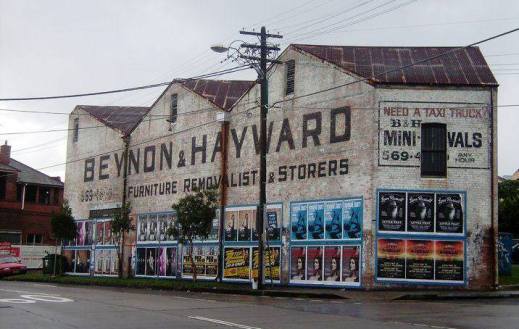
Occasionally one gets relegated to the sidelines in this age of heritage mayhem while family matters, other choirs, and real jobs get in the way. But then something happens – a misguided decision by an ignorant council or a just plain silly comment by some rogue councillor that lights a spark inside that makes you want to take up the charge again.
This time the council is Marrickville, and it relates to their decision to totally ignore the advice of their own heritage advisor’s report and not heritage-list the unique 1886 brick warehouse at 6 Livingstone Rd. Petersham owned by Beynon & Hayward furniture removalists and storers. The building was linked for many years to James E. Gould, a local produce merchant who served as Alderman and Mayor on Marrickville Council over a period of over 18 years, and was purpose-built to suit the narrow triangular site over two stages between 1886 and 1904.
Certainly the shape of the building is quite individual, and from some angles almost looks like something conceived by the mind of the great Dutch illusionistic artist M.C. Escher. That combined with the corrugated iron roof and a real ‘wild west’ silhouette has made the warehouse quite a landmark for locals and visitors passing by on their daily commute.
Already the council has been slammed by the Australian Institute of Architects and the National Trust for not considering the much loved warehouse important enough to place in protection of a listing. On the contrary, certain councillors are calling for it to be demolished in favour of units or a carpark. Independent councillor Victor Macri has notably referred to it as “an eyesore”, seemingly oblivious to the rare heritage qualities of the shape and form of the classic 19th century warehouse.
I think it is a wonderful building, and find Cr. Macri’s attitude extremely dangerous for a councillor in a renowned heritage area such as Marrickville to have. I don’t believe he reflects his ratepayers’ beliefs in any way, and if you are a resident within the Marrickville council area with any sort of knowledge and respect for Australian merchant heritage, perhaps you should think very carefully before giving people like this any semblance of power at the next local elections. Hopefully the building will still be standing by then.
Looking at an aerial view of the site, council’s intentions become clear. To expand the neighbouring council-owned carpark by simply eliminating the warehouse is just taking the easy option. The fact that Cr. Macri owns a hairdressing salon on Marrickville Rd. may tilt his opinion on the need for more local parking somewhat.
In any case the thought of replacing a heritage building such as this with a carpark is an outdated one. One similar example that comes to mind took place at Mortdale a couple of years ago when a local Masonic Hall was bulldozed to make way for an unnecessary carpark, and was widely deplored by residents all round.
The need for more carparks will be totally dependent in the future on the use or over-use of cars. The car as a mode of transport will one day become redundant as the road system fails to cope with the increase in traffic to the point where it simply breaks down to total gridlock altogether. Certainly in the current phase of government initiatives there is little contingency for this forecast situation except for building more carparks. Will that solve the problem of over-congestion, or will it simply encourage more of the same? Marrickville Council seems to think it is part of the solution, and aims to sacrifice important local heritage to achieve this short-sighted goal.
At least some voices of reason on council still seem to recognise the importance of putting heritage ahead of whimsical planning folly. Liberal councillor Mark Gardiner stated to Fairfax “It’s not for councillors to decide what buildings are important. It’s for councillors to take the advice of heritage experts and they are saying strongly that this building is important.”
Indeed it is important… As a general rule if an expert heritage report states an item is important, it probably is. That’s why it is written by an expert. And if a council is voting on the future of a heritage building, but that same council owns a carpark next door that it wishes to expand, that, to me is called a conflict of interest. Will this conflict of interest be the death of another iconic heritage building in Sydney’s suburbs? We all have the right to voice our concerns and condemn what we know is wrong.
Inheritance has written to Marrickville Council to formally object to their decision.
Main title image by Jo Catherine.
WAR MEMORIAL SYNAGOGUE ACKNOWLEDGED

This is another good news story – amazingly that makes our second for the year, I think I need a Valium. It relates to a former synagogue in Strathfield, and the local council’s unusual move to heritage-list the building against the wishes of its owners. This doesn’t happen every day, for some councils it doesn’t happen every year, and for many it doesn’t happen at all. So first and foremost our congratulations go to Strathfield Council, who passed the motion 4-1 at its 21 May meeting, and of course Mayor Daniel Bott who initiated the heritage listing.
Naturally for every good deed there is a denier, and in this case it is the New South Wales Jewish Board of Deputies, who represent the building and the land it sits upon, and have declared their intention to sell off the synagogue as a prime development site. This is despite Strathfield Synagogue vice-president Sam Steif telling the Australian Jewish News in 2011 that “the only way we are going to get a minyan is if we put a mirror on the wall, but we will not sell the synagogue… If we got to that point I would go to the Jewish Communal Appeal and the NSW Jewish Board of Deputies and do anything I could to save it because this is a war memorial synagogue and we need to keep it.”
Unfortunately for the Jewish Board’s plans for sale, the heritage listing has complicated matters somewhat.
Built in 1959, the synagogue, known as the War Memorial Synagogue due to its internal plaques adorning the walls that commemorate Jewish victims of the Holocaust, was closed in 2011 as a result of shrinking congregations. The multicultural area was once rich with postwar Jewish immigrants, but over the ensuing decades the demographic has obviously changed as many of the Jewish families have moved away.
A preschool that operates on the site was initially set up for Jewish children but now caters for the greater community, and despite the closure of the synagogue, the site still operates at a profit thanks to the ongoing preschool lease.
Samuel Tov-Lev was the resident Rabbi for 15 years but his contract has since been terminated and he was effectively locked out of the site. He has campaigned for the heritage listing of the synagogue against the Board’s aspirations, and gathered 12,000 signatures in support. He sees the heritage of the building as unique in the area and deserving of recognition and retention. When asked about the successful heritage listing by Australian Jewish News he replied “I’m pleased but at the same time I’m very sad to see people calling themselves Jews fighting to destroy the holy and sacred synagogue.”
The Jewish Board of Deputies sees it only as an unexceptional building that contains plaques that could readily be moved to the centralised Sydney Jewish Museum. They have even gone so far as to say the naming of the ‘War memorial Synagogue’ was purely for taxation reasons, as memorial items attracted tax concessions at the time.
What they fail to acknowledge is that the heritage of the site is more than just the plaques that can be lifted and replanted elsewhere. It is, as with all heritage listed items, the synergy of the whole… It is the presence of the plaques, within the community where it was created, it is the modernist building design that reflected a new life for many postwar Jewish immigrants, away from the trauma of war, to a new country, a new community, so welcoming and accepting of refugees and settlers from all corners of the globe, and the symbolism that represents. It is the growth of that community to form a new society in a land so far away from their roots. It is the freedom and acceptance that made Australia such a reliable refuge for peoples removed from their homelands. And the simple walls of this synagogue represent much of that sentiment.
I think, despite the Jewish Board’s opposition, that Jewish people in general would be grateful for the protection of this historic suburban synagogue. I think that residents of Strathfield would be grateful for their council’s bold actions. And I think Australians in general would be grateful for the preservation of a piece of multicultural heritage, a small contribution to a country so great that people traversed the globe en masse because they wanted to live here – and part of keeping that country great, an important part, is maintaining its heritage for future generations to see, not just internal fixtures but the physical structures – and that blinding truth, unfortunately for some, far outstrips the requirement to make real estate profits to the maximum level.
Link to Strathfield Council’s Heritage Review of the War Memorial Synagogue site here.
Main image courtesy Australian Jewish News.
Thanks to Quentin Dempster on ABC’s 7.30 New South Wales for publicizing the story.
HAMMERHEAD vs. KNUCKLEHEADS – KNUCKLEHEADS WIN

On a golden Autumn afternoon in Sydney I decided to take a stroll around the Botanic Gardens with my little daughter in tow. To one side, the idyllic aspect that every tourist knows, a postcard scene – the Sydney Opera House with its gleaming sails of iridescent white, and the iron-clad Harbour Bridge, hanging over a dreamy jade body of water, ferries plying the glistening waves en route to Woolwich or Manly or somewhere similarly exotic. To the other side, a slightly less celebrated but no less beautiful vista of harbourfront workings – Garden Island with its sleepy naval fleet, grimy Woolloomoolloo with its workers’ pubs, pie carts and Finger Wharves jutting out from crowded streets, and standing above it all bathed in afternoon sunshine, the genuine industrial grandeur of the Hammerhead Crane that marks the spot so well and has been a permanent fixture on the Sydney horizon for more than fifty years…
Of course I knew all that was about to change. Mounted high on top of the Hammerhead Crane there are smaller demolition cranes already working away picking apart and lowering pieces of the giant icon one girder at a time. Like soldier ants crawling over a stricken carcass they rummage through at a steady pace and soon enough the entire structure will be nothing more than an unidentifiable decomposing pile of scrap.
It didn’t have to be like this…
Department of Defence bureaucrats set the wheels in motion some time ago, and the matter was put to bed by a former Minister for Sustainability, Environment, Water, Population and Communities Tony Burke who is now nursing his cushy job as The Manager of Opposition Business in the House, while another pack of equally inadequate politicians take hold of the reigns of power.
When the sad news broke, I tried to garner support for the retention of the crane. I wrote the successive Ministers, without response. I wrote the proprietors of similar cranes in Scotland who have turned their investments into feasible tourist attractions. I wrote the nearby Art Gallery of NSW for support from an arts perspective, the State Library of NSW, Sydney writer’s groups, all without success. I even tried UNESCO as the removal of the Crane poses a clear contravention of the World heritage guidelines for the Sydney Opera House which recognise that the views and vistas between the Opera House and other public spaces within that buffer zone contribute to its world heritage value, and should they be altered, the World Heritage status of the Opera House would be seemingly diminished.
But support was difficult to find in any quarters…
Andrew Woodhouse, President of the Potts Point and Kings Cross Heritage Conservation Society shared my concerns and offered his voice to the cause, but more opposition was needed… Much more, and it wasn’t forthcoming… I would certainly have expected more resistance, in a city of five million, pertaining to what many would consider the death of a city icon, indeed a very important piece of naval heritage – either it was misplaced or just wasn’t there at all.
On this day my daughter’s eyes were drawn to the crane from a grassy verge on the western side of the Botanic Gardens… “Crane!” she exclaimed. “Yes. Let’s go and look at it” I suggested, knowing it would probably be both the first and last time she would see it, or at least recognize it as a crane. We ambled over the hill to a pleasant view above Andrew ‘Boy’ Charlton Pool, and cast our gaze over the bay. As usual, a couple of old navy hulks were tied up to the wharves. The Hammerhead stood with as much effortless grace as ever, despite being infested by the demolition cranes, clinging hungrily to its massive frame.
My daughter watched in awe as I explained to the fragile mind of a two year old, that, as beautiful and significant as it was, she may not be able to see the crane again. “Big crane going down” she quipped, and burst into a shower of tears. “Yes,” I calmed her before lightening the tone… “Little crane going up” she consoled herself, but it became crystal clear in my mind, that a two year old girl seemed to have more respect and regard for the heritage of our working harbour than the knuckleheads who had anything to do with the demise of this icon – and they are knuckleheads, I couldn’t think of a less insulting term to conjure up for these bureaucratic buffoons who play silly games with things of state and national signidficance they don’t have the right to. Illustrative of this point, is the outrageous display of public money that was sunk into a fireworks display for the recent Navy Fleet Review to celebrate Naval ‘heritage’, a cashpot that would have gone quite some way into saving this crane, the tangible evidence of naval industrial heritage in Sydney harbour for half a century. Instead we had a fireworks display that lasted minutes.
We turn and walk into the fading sun. At this time of the day it dips sharply over the Domain and through the concrete shadows of the nearby city. Our return way meanders past the successfully re-purposed (and once slated for demolition) Finger Wharves, exuding maritime heritage, before passing right by the sandstone edifice that is the Art Gallery of NSW, and the shady Speaker’s Corner of the Domain before finding St Mary’s Cathedral and Hyde Park. Such a historic walk through the richly textured layers of old Sydney, a walk that will now be somewhat poorer for the loss of the Crane…
A plaque on top of the Speaker’s Box reads “Stand up and speak your mind.” If more of us don’t head this call, if we don’t stand up for our heritage, if we sit idly by and allow it simply to fall away, if we allow these knuckleheads and bureaucrats to win we will all be the poorer; much more will be lost until there is almost nothing left to preserve, and nothing will ever, ever change. We will all be the poorer for it. The unnecessary and negligent loss of the Hammerhead Crane will become lasting proof of that.
THE CHANGING FACE OF FORSTER-TUNCURRY

Sydneysiders are familiar with the seaside holiday town of Forster on the NSW mid north coast. Many of us have spent summer vacations in and around the centre, with its abundant beaches, rivers and lakes offering plenty of outdoor activities for the visitor. As a result of this popularity the skyline of Forster (and its twin town Tuncurry to the north) has burst sharply skyward over the years, as open real estate around the town becomes scarcer and developers move in to take advantage of the area’s cashed up holiday rental crowds.
On my last visit, I found something I didn’t really expect – a formerly sleepy seaside hamlet on the verge of much bigger things. Already several big towers have sprung up creating more of a Gold Coast style resort, leaving in their shadows vast chasms of crumbling vestiges of bygone days; fibro beach shacks and modest brick freestanding cottages, all but now slowly disappearing under the growing weight of modern skyscrapers.
What amazes me is the speed at which Forster and towns like it are changing, and just how easy we are to throw away any pieces of our past like scraps of bone to a hungry dog. Every corner you turn in Forster you see For Sale signs propping up decrepit buildings, or safety barriers around abandoned houses and 60s era motels, as they are no longer seen as profitable and either left to rot or handed over to caretaker real estate agents to find suitable developer buyers who have no qualms about turning these little slices of history into contemporary piles of rubble, with their high volume high density money making concrete cubes rising from the ashes…
So who will miss these vestiges, these quaint beach style fibro and brick cottages with their dried up gardens of hibiscus and frangipani that have served their purpose well over the years but just don’t make the cut anymore in this profit orientated, market driven, real estate focused society we call Australia?… I for one. I see the beauty in these buildings, these modest, airy, charming, homely remnants of a disappearing world that have been unashamedly sold out exclusively for the real estate value of the dirt on which they sit.
I believe the council and state government should be looking at the heritage value of certain examples of this style of Australian coastal architecture, c.1920s – 1960s and preserving them rather than allowing wholesale destruction, and at the same time applying the brakes to the total redevelopment of coastal towns like Forster, which is occurring more rapidly than many would like.
‘Tikki Village’, pictured below, is one example of a land sale that recently occurred for over a million dollars, presently holding several ornate little fibro cabins that serve the community with cheap long term rental options, but zoned for medium density development and at risk of being turned into towers.
If you want to see the real Forster, the old Forster as it was, you’d better go soon as much of it is rapidly changing. Locals are quick to point out how the character of the place is briskly disappearing, never to return as it was. Below is a gallery of photos of the town, including ‘Tikki Village’, but be warned, many of the buildings shown won’t be there for very much longer, or may in fact already be gone.
All photos copyright Inheritance.
BATTLE BREWING FOR HOTEL AUSTRALASIA, EDEN

A battle is brewing in the NSW South Coast seaside port of Eden. It involves something very dear to the hearts of residents of any Australian country town, the local pub. The famous Hotel Australasia on Eden’s main street has stood like a fortress overlooking the fishing hamlet for 110 years… It has quenched the thirst of former whalers, seafarers and sleeper cutters and has welcomed in more recent times the throngs of summer tourists that come to Eden for a taste of the authentic south coast experience.
Sadly the pub, known affectionately by locals as ‘the pit’ closed down in 2013 as the family owners struggled to come to terms with expensive repair work to the roof and structure of the building. It was put on the market and eventually bought up by Great Southern Developments, a company that quickly sold on the poker machine licences for a tidy profit, and now intends only to knock down the historic hotel, and replace it with a generic big brand supermarket, a liquor store, and retail shops.
History-conscious locals have petitioned the Bega Valley Shire Council into taking a stand and putting the building on the local heritage register. They fear the town will lose a big part of its character should an integral landmark like this disappear, only to be replaced by another modern day dreary box of consumerist bricks and mortar, one that would render the town no different to any other that allows such soul destroying bland architecture in place of the heritage that once stood (Ulladulla, anyone?)
In fact it is a crime to even contemplate knocking down a pub as outstanding and historic as the Australasia, one that helped shape the township of Eden, over many decades, one that has been at the centre of the community, one that tourists and locals alike can immediately associate with its surroundings. The pub is the town and the town is the pub. And even if the pub is not a pub anymore, then the building should remain for posterity.
It has been suggested that the facade at least would remain, but that notion has recently been flatly rejected by the developer who obviously wants to cash in on every square metre of their investment, regardless of what is wrong or right. Talking to locals recently I learned that many even question the need for a third supermarket in town, two serve the population adequately as it stands.
Council’s Heritage Adviser, Mr Pip Giovanelli, Heritage Architect stated in a 14 May 2013 report:
“Full demolition of all buildings on the site would not address heritage values or community expectations. It would lose an important urban design element from the Imlay Street streetscape and would deny the option for a future owner to restore the building and reinstate a potentially very valuable tourist element into the town. This last point is very important as it is often the historic buildings that are sought for restoration and adaption when towns such as Eden cycle into economically more prosperous times. The recent restoration of the Royal Hotel in Queanbeyan is an excellent example.
…Retaining the historic front part of the building and erecting a supermarket behind would appear to be a workable strategy. A similar example of this approach is currently being done in Gipps Street Bega, where the historic Central Hotel is being retained as a two storey frontage behind which is the main supermarket accessed via the former carriageway. The rear of the supermarket will have a sympathetic frontage to the Coles carpark.”
It is right for council to nominate the hotel as a heritage item, but the developer is now taking the case to the Land and Environment Court. They believe the listing has come too late, and feel they have a God-given right to do with the land whatever they want to. So on one hand we have the concerned residents who simply and justly wish to retain the heritage and individuality of their town for future generations to enjoy, and a council that has heard their concerns. On the other hand we have the cashed-up developer who has snatched themselves a bargain property right in the town’s high street, doesn’t give two hoots about the subject’s history or visual townscape impact, and is acting like they are doing the townsfolk a swell favour by building another supermarket that they don’t actually need.
There is a simple solution to all this, and it is a win-win. And this could apply not just to Eden, but statewide, in fact nationwide… Leave the historic building alone, keep mundane and ugly oversized modern development OUT of high street, and build it on the fringes of town or somewhere less intrusive and somewhere where it is going to cause, oh I don’t know, less embarrassment to the people of the township… Everyone’s a winner and then not every town will look the same within about ten years. People can still then take their friends for a walk and point out the beautiful heritage of buildings like the Australasia and say “that’s a century-old watering hole…” rather than, “oh that’s another Woolworths, Coles or IGA…”
Appeal date in the Land and Environment Court is 28 April 2014.
Click on thumbnail images in gallery for slideshow… Colour images Inheritance, historic images courtesy Angela George’s collection / State Library of NSW.
THREE GENERATIONS OF BAY ST. FELLED FOR UNITS

Three generations of architecture sitting side by side are to make way for units along Rockdale’s busy Bay Street leading down to historic Botany Bay. A simple 1800s workers’ cottage, a free standing Victorian villa complete with original slate roof, and a brown brick Federation have been vacated and await demolition surrounded by a fence of doom, in an area that has the highest expansion rate for unit building currently in the state. A DA to turn the site into 19 strata units was lodged in December 2013 by applicants J & M Faddoul Pty Ltd, at a building cost of $3,275,000.
Rockdale Council seems to find no heritage value in these items that have stood for more than a hundred years and overlooked the constant march of progress stemming up from Botany Bay and down from the town centres where Thomas Saywell’s famous steam tram once traversed. Instead more and more units have now become the order of the day. Even a now rare workers’ cottage can’t stand in the way, nor a stunning double storey Victorian villa with many ornate original features, reminiscent of the recently lost Griffith House on the grounds of nearby St George hospital.
It seems an unnecessary shame that buildings like this are allowed to be felled continuously in this so-called enlightened age, in fact the rate of heritage loss seems to be increasing as large swathes of Sydney are rezoned for unit development, a trend which will no doubt spell the end for many similar buildings especially in areas such as Rockdale, where councils simply don’t have a clue as to their duty of guardianship, choosing rather to tow the Liberal state government line of urban renewal at all costs.
Rockdale Council is currently assessing another potential overdevelopment on the nearby Darrell Lea site on Rocky Point Road. The chocolate factory is to make way for between 350 and 600 dwellings, rising over the 3.3 hectare site in towers up to 12 stories high, within a LEP that currently allows four. In order to accommodate this scale of development, the land would have to be rezoned to R4 high density residential, a move which Rockdale Fifth Ward Ratepayers Association disagrees with, citing privacy, traffic congestion, and lack of amenities (there is no rail station nearby). However Rockdale Council has already adopted a motion to support the planning proposal, meaning residents may just be left as innocent bystanders in the process. Long live democracy in Australia… At least the developers have theirs.
All images by Inheritance. Click on gallery below for slide show.
BURWOOD BEAUTY IS IN THE EYE OF THE DEVELOPER

A beautiful Federation mansion in Burwood is now under imminent threat of demolition following the lodging of a DA to build eight townhouses on the 1853sqm estate. The six bedroom property, at 18 Wyatt Avenue Burwood sold at auction in April 2012 for $2,950,000 to Mr. Zhou who placed the DA in October 2013.
The house was once owned by Edward ‘Red Ted’ Theodore, who led an illustrious career as a Union leader, Queensland Premier and Federal Treasurer under the Scullin Labor government during the Great Depression, later making his fortune as a private business partner of Sir Frank Packer setting up gold mines in Fiji and holding the position of Chairman of Directors within Packer’s publishing giant ACP. Theodore has been described as a radical thinker of his time and has been immortalized with both a township in Queensland and a suburb in Canberra named after him.
The house backs on to the heritage listed Appian Way, and forms part of the fabric of the heritage-rich Burwood area, a landscape local residents fear is being eroded piece by piece if proposals like this are allowed to gain traction. That fabric was tethered a few years ago with the loss of the magnificent Federation mansion Tilba to a unit development – this new case is already drawing comparisons and can be seen as another litmus test of just how determined council are to protect the significant heritage assets of Burwood that happen to fall just outside their rather inadequate conservation zones.
Worryingly the determination of Burwood Council may not be where it should… The council’s heritage architect has already approved demolition of the property. It is now before councillors for final approval, who have received 39 letters of objection amongst a growing tide of concern by residents who have invested significant amounts of money to live in an area they see as a stronghold of Federation era heritage and a charming suburb of aesthetic beauty in its own right.
President of the Burwood Historical Society Jon Breen knows all too well about the imminent danger not only for this house but the suburb in general. “This side of Wyatt Ave has always been seen as a bulwark or protection zone for the internationally significant precinct of Appian Way,” he told Burwood Scene. “Twenty years ago the National Trust proposed a buffer zone around Appian Way to protect this unique and historically important area. Such a buffer zone would have stopped the demolition of a number of historic buildings.”
On the other side, building company Ausray International appears to see this as a done deal, already advertising the new townhouses on its website under the name ‘Ausray Wyatt Place’, making enlightening claims that “18 Wyatt Ave, Burwood is located in the best street in Burwood, it has best combination of character homes with peaceful leaf and green areas.”
…umm, is that one of the so-called character homes that you just applied to demolish?
Inheritance has joined the fight by writing a letter of objection to any intention of approval. Our associate NSW Heritage Network have done the same. What remains to be seen now is whether Burwood Council will side with the concerns of residents they are meant to represent, or side with a new breed of developer-buyers who are more than happy to invest in the area purely to knock down these magnificent treasures in order to turn a quick profit and at the same time destroy the wonderful local heritage these homes represent. Considering 18 Wyatt Avenue sold for $2,050,000 back in July 2002, an average profit of $90,000 a year was made by the previous owner just by holding onto the property, which goes to show you don’t have to demolish to make money out of real estate in Sydney. Just treat it with the respect it deserves.
Link to Burwood and District Historical Society ‘Changing Scene’ page showing multiple heritage demolitions around the area.
Main title image federation-house.wikispaces.com
THE FATE OF FATIMA ISLAND
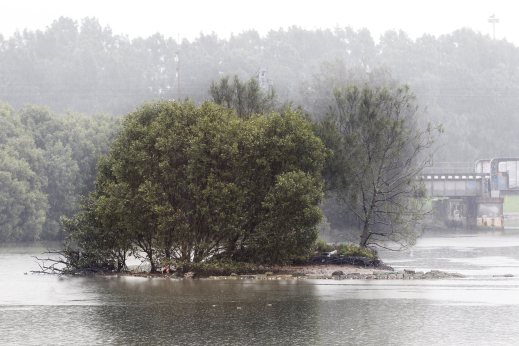
We begin the year on an island. Which is not an unusual circumstance for a heritage advocate… But don’t let me lead you to believe this is another negative news story. No, we are starting on a positive note for a change (hopefully)!
Fatima Island, on a bend in the Cooks River at Tempe, is a small vegetated mudflat that has been disintegrating by the year. Now it has come to the attention of the Cooks River Valley Association who have duly raised awareness with Marrickville Council.
The island will be immediately recognisable to the many commuters who travel by train into the city every day along the Illawarra Line. As the city bound train crosses the bridge at Tempe the island comes into view from the east – I can clearly remember over my years of commuting to the city, looking out and seeing the little island sitting there, often populated by waterbirds oblivious to the rapid urban development encroaching all around… Fatima Island, and closer to Central, Sharpie’s Golf House sign, the first electrified advertising sign in Sydney, taken down in a blatant act of heritage vandalism several years ago – these were the two landmarks that stand out in the memory of my daily commute whilst peering out of the train window.
Although Sharpie’s Golf sign is long gone, sadly never to reappear, Fatima Island is still clinging on to the riverbed in its isolated vulnerable form. It is in fact the last remaining of a series of natural sand bars, and provides vital pest-free habitat for waterbird species including pelicans, ibises, cormorants and seagulls.
The island’s sandstone retaining walls, made of reclaimed convict hewn blocks, were built in 1901 as part of a public works program, but the naming of the island came about 50 years later. Remembering a monastery stood just across the river near Tempe House, The name ‘Fatima’ has it beginnings in a local Catholic Rosary pilgrimage in 1951 on the banks of the Cooks River to honour Our Lady of Fatima, channeling the Portuguese icon of the same name. At the time, Pope Pius XII asked Catholics across the globe to pray to the Virgin Mary ‘with greater fervour of the heart as is demanded by the increasing urgency of the need as well as the conversion of Russia back from communism.’
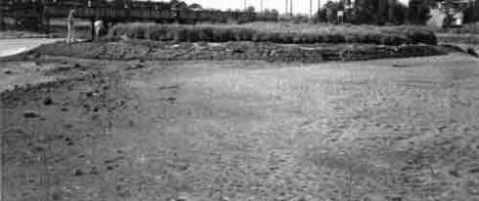
Fatima Island in 1984. Photo by Chrys Meader. Source Marrickville Heritage Society & Cooks River Valley Association.
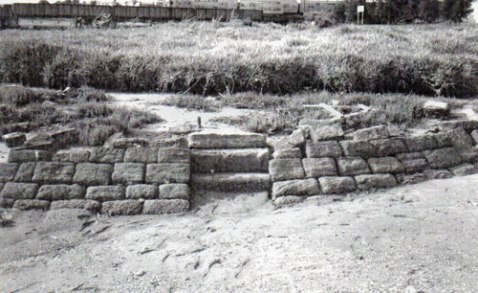
Fatima Island in 1984. reclaimed convict stone retaining bank present. Photo by Chrys Meader. Source Marrickville Heritage Society & Cooks River Valley Association.
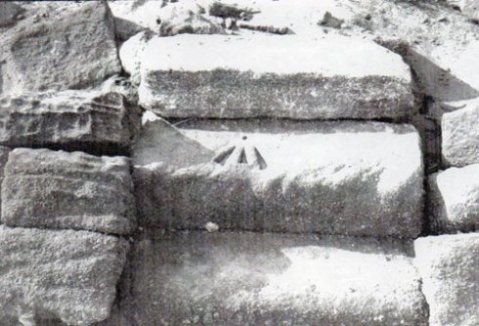
Fatima Island in 1984. Note convict markings in steps. Photo by Chrys Meader. Source Marrickville Heritage Society & Cooks River Valley Association.
The wall has recently all but washed away due to factors such as boat wash, human visitation, de-stabilisation and natural erosion. The island is now only a fragment of what it once was, trees have fallen over and top soil been stripped away, and the next phase would be its complete loss in time.
Marrickville Council seems to be listening to concerns of local groups including Inheritance. In response to our submission and at a recent council meeting the feedback has been positive, and it now seems that Marrickville Council will be allocating $25,000 for a remediation works study on Fatima Island. This will go some way to restore what is esentially a significant bird habitat, a known piece of local heritage and a quirky piece of nostalgic landform with links not only to the Catholic Church, but the local Portuguese community and 1950s cold war!
Something as unique as this is surely worth protecting. And it is indeed heartening to see a council actually acting on behalf of a community for a change.
Main image John Veage, the Leader.
NAVY FLEET REVIEW: AN OPPORTUNITY MISSED?

I like many other proud Australians ventured into Sydney Harbour over the October long weekend to take a look at the marvellous celebrations based around the Royal Australian Navy’s centenary and Fleet Review. It was 100 years to the day on 4th October, when 7 ships of the original fleet of the newly formed Royal Australian Navy sailed through the heads and into Sydney Harbour. Now, tremendous festivities were held to mark this great occasion, including a re-enactment of the entry by modern warships of the RAN and a flotilla of international ships representing 17 nations, a parade of 16 historic tall ships from around the world, RAAF fly-overs, fireworks and light show spectacular and of course the visit of His Royal Majesty Prince Harry to review the fleet.
Considering the enormity of the occasion, marking 100 years of continuous service of the Royal Australian Navy, through two World Wars, Korea, the Cold War and more, with all the tradition this entails, I can’t help reflecting what a shame it seems now that the Hammerhead Crane at Garden Island, a perfect backdrop to the passing parade of warships, will be sacrificed by the Federal Government for the sake of saving a relatively small amount in maintenance costs.
When you look at the costs involved in putting on this Fleet Review, a whole lot of pomp and ceremony that lasts only a few days – and enormous costs they are, 40 million dollars to taxpayers including a 10 million budget to keep the ships tied up and open, it seems so deceptively wrong that the Australian Defence Force has cried poor this whole time not being able to find the relatively modest funding of $700,000 in maintenance required to upkeep the Hammerhead Crane. This after all, would be the ultimate lasting tribute to the heritage of the Navy in its 100th year – a full restoration of a Sydney icon and renowned symbol of the Royal Australian Navy… A distinctive feature of the Garden Island base and the Sydney Harbour skyline, a truly extraordinary piece of Naval engineering and an asset to the people of Sydney.
To spend just a fraction of what was outlaid for a ten minute fireworks display would have truly left a far more lingering impression in highlighting the longstanding heritage of the Navy in Australia and in Sydney Harbour. While the fireworks quickly went up in smoke like every other generic New Year’s display, the preservation and restoration of the famous crane would have been timeless and benefited Australians for far longer than just ten minutes.
Of course I am not anti-celebration… Just let’s make heritage part of the celebration… It is a celebration of Naval heritage after all…
I guess it may be just too much to ask, perhaps a little too illogical in today’s throw-away society, that a living piece of naval architecture be preserved for posterity as opposed to watching 3.9 million dollars worth of lights and gunpowder smoke go up into thin air.
Still, when future generations look back at 2013, the centennial year of service of our great Royal Australian Navy, and they see that the defence budget allowed for 40 million dollars of tax payers’ money allocated to a single weekend spectacular, while $700,000 couldn’t be found for the long term preservation of a heritage icon, they may just be scratching their heads and wondering if the spectacular Navy Fleet Review was little more than just an opportunity lost.
All images below Inheritance. Click on one for slideshow (not the 40 million dollar kind)… Title image of fireworks courtesy ABC.
‘THE SHIRE’: A TALE OF THREE JETTIES

There’s something almost surreal about standing and looking over an object that fits into its environment perfectly, that enhances its surroundings simply by being there, that seems like it has been there forever, but is set to disappear from view, for the whimsical short term gains of a clearly ignorant and questionably shady council.
Three jetties in the Shire (one at Gunnamatta Road, Cronulla, as well as the Scylla Bay Boat Ramp and Wharf, Como, and Burraneer Jetty at Lugano Avenue, Burraneer) have been earmarked for removal by the pathetic Sutherland Shire Council due to maintenance costs the council is simply not willing to wear. This is the same Liberal dominated council headed by (until recently) Mayor Kent Johns who is reportedly under investigation for accepting political donations for his Federal Campaign from property developers in exchange for reciprocal favours, at the same time rezoning large tracts of the Sutherland Shire to allow massive and unprecedented high rise developments, getting rid of the ombudsman who oversees corruption and even going so far as to protect developers from legal action against any wrongdoings. See the details here.

The questionable ex-Mayor Kent Johns. With power brokers like these at the helm of council, heritage is in trouble. Image John Veage.
For the locals of these areas, the jetties represent something more than just a form of aesthetic beauty. There is a function performed, a duty as it were, to the people of the Shire. Somewhere boats can tie up, kayaks can launch, a lazy line can be cast, and a sunny afternoon squandered happily away. There is nothing quite like sitting on the edge of a rickety jetty, dangling your feet over the edge, and mulling over a quandary or two while admiring the view of the world listening to softly lapping waters. Australia is a country designed for these jetties, and their loss makes us all a little poorer. Certainly our bays and hamlets would seem rather naked without them.
Heritage they are of course. Standing for many years and serving their purpose with quiet esteem, requiring very little to maintain in return, and beautifying the outlook like nothing else can. The Burraneer jetty stands watching the return trip several times every day of the 74 year old M.V. Curranulla, the Cronulla-Bundeena ferry, the oldest commuter ferry in fact in Australia working to a regular timetable. The jetty returns the favour, giving the passengers something to look at too, adding unquestionably to the maritime heritage of the bay and the Port Hacking River.
It appears as though this particular jetty suffers from sag due to insufficient and rotting piles holding its weight. A few more piles added and a bit of straightening would solve this problem, a far better alternative than the destruction of the wharf.
The other, at Gunnamatta Road, Cronulla (over 100 years old and formerly known as the ‘Hospital Bay Wharf’ built for taking quarantine cases from coastal vessels) doesn’t appear to have condemning maintenance issues at all. This one has received the most public attention, and may have garnered enough support to be saved yet, attracting a petition of 850 signatures in only 14 days, despite the council ignorantly rejecting and insisting the submissions be lodged electronically.
A third jetty, the Scylla Bay Boat Ramp and Wharf, at Verona Range, Como, is also proposed to go, but this one would at least be replaced under council plans.
At the time I investigated the Burraneer Jetty, it was a beautiful day, the sun was shining through an azure blue sky onto glowing waters. The Bundeena ferry chugged closely by as it had for many decades. I admired the reflections from crowded rock pools and sandy shallows up to the splintered hardwood timbers of a timeless whitewashed jetty.
While over at Gunnamatta Road, the view from the hill above was sublime. Stepping down the 1912-built steps carved out of sandstone onto the wooden landing is like stepping closer into a scene from paradise. Postcard-perfect, soaked in sunlight and there for us all, free of charge. A beautiful piece of man-made infrastructure that enhances its surrounds immeasurably while allowing the user to actually immerse himself and become part of the scene – such a rarity in any form.
A local was nearby, an old-timer looking over the scene. “Are you a local?” I asked.
“Since 1939” was the reply. But he seemed oblivious to the imminent loss of the wharf…
“That’s the wharf they want to get rid off” I commented.
“I hope not… This place is magnificent” was the reply.
If only he knew.
All images below by Inheritance 2013. Click on one for slideshow.
SMH story: Sutherland Council favours those with Liberal connections
SMH story: Rainbow Connections
SMH story: Cloud over ex-minister’s campaign donations
SMH story: September 21, 2013
SMH story: September 22, 2013
SMH story: September 26, 2013
SMH story: October 2, 2013
THOMAS HOLT’S SUTHERLAND COTTAGE: ON CLOSER INSPECTION

Picture a cottage, if you will…
Not one that gets its glow from brightly whitewashed walls under a tightly thatched and bound wheat straw roof. Not one that breathes the soft air of lavender down a misty cobbled path behind box hedge in an English country garden. But something more rugged. Something more natively suited to where it finds itself, something that reflects the brashness and personality of a people and a land once far removed from the rest of civilisation, a distant and wild place that took in the unwanted element of British society, flung across the high seas; a new and fledgling colony where things, as they have thrived and progressed, could just as easily have withered and died away for good had it not been for the determination and sheer tenacity of its new inhabitants to make it succeed.
Such a cottage exists.
Not on the dusty weathered plains beyond the Great Dividing Range, although there are such things there. Not in the rustic shambolic remains of gold diggings scattered through towns along the dry western rivers and creekbeds, although there are such things there. Not in the rugged windswept landscape of an Arthur Streeton oil painting, though such things certainly are there.
This cottage exists in the very heart of the palm and grevillea tinged suburban ideal of the Sutherland Shire, a southward expansion of the city of Sydney, only footsteps from the lapping waves of Botany Bay, that hallowed body of water where Cook and his party came ashore to pronounce a new foundation of European acquirement.
In the years and decades that followed that initial landing, the colony would grow and augment, to the west, the north and south. Free settlers would arrive to replace the legions of convicts, commercial trade would be born, farming and working of the land to feed the bustling colony, building and development expanding into an almost limitless boom that continues to this day; fortunes would be made, by those willing enough to take an entrepreneurial chance.
One such fortune was that of the English immigrant Thomas Holt, born 14 November 1811 in Yorkshire, who came to Australia in 1842 and gained great wealth and fame as a wool trader, financier and businessman.
He soon became a successful landowner, building six mansions south of Sydney, including a Victorian Gothic grand estate ‘The Warren’ in Marrickville. He invested in over 3,000,000 acres of pastoral land across NSW and Queensland and consolidated more wealth selling holdings after gold was discovered in the 1850s. He was at various stages a director of the Sydney Tramway and Railway Co. as well as City Bank. He was also a successful parliamentarian, being member of the inaugural Legislative Assembly and the first Treasurer of the colony.
Later in life he would found the Royal Prince Alfred Hospital, before returning to the country of his birth and continuing charitable work for the Salvation Army and the Rev. A. Mearns and Dr Barnardo, publishing Christianity, or the Poor Man’s Friend before passing away in 1888.
Among Holt’s many achievements he also holds the dubious honour of playing more than just a minor part in Australia’s great rabbit plague, after several of the beasts escaped from the grounds of his well stocked Marrickville mansion ‘The Warren’ and hopped off into the Sydney sunset. The rest, as they say, is history.
In the 1860s Thomas Holt acquired a considerable tract of land of some 13,000 acres around Kurnell in the Sutherland Shire, including Captain Cook’s landing site. It was here he constructed Australia’s first oyster farm at nearby Gwawley Bay. As the estate in Sutherland grew, he employed teams of workers on site digging the oyster claires and tending the property, and in the 1870s established his final mansion known as Sutherland House complete with English park landscape over 786 acres.
The cottage that we speak of was part of Thomas Holt’s Sutherland Estate. It was one of three similar workers’ cottages situated at the centre of the holding, and is in fact the only surviving remnant of this once grand and historic estate. It was probably inhabited by gardeners, coachmen or general hands and their families, as can be seen by the basic character of its workmanship and unadorned decoration. Its construction is of simple weatherboard. It has a corrugated iron and skillion roof to keep out the rain, and a large wraparound verandah to keep the walls cool through the beating hot summers. The brickwork of a later laundry addition remains on the back side of the property, while inside it retains “original lath and plaster walls and ceiling linings, and original ledge and sheeted internal walls.”
Official dating can be difficult due to the nature of the long-running design use of such cottages, however it is typical of a style of architecture once prevalent in the Shire, and can be traced to be a product of at least the 1870s. As such, it remains one of the oldest buildings in the Sutherland Shire, often reported to be the oldest. The offset angle to the street frontage is testament to the true age of this building.
When Thomas left the estate, the land was sold to his son Frederick who resided there for thirteen years with his family before leasing the mansion to Mrs Mary Hamilton in 1894 for use as an infirmary. In 1908 the property was subdivided including the worker’s cottage which was sold at auction on 20 April 1908 with 33 acres. It was once again subdivided into two lots in 1952, but remained relatively unchanged as a structure, being owned for a continuous period of 70 years by the one family, of which Jan Buchanan was the last resident. During this time it was known as ‘The Gunyah’ which is an Aboriginal term for humpy or crude bush shelter.
In 2003 Sutherland Shire Council bought the property from Jan Buchanan for the sum of $610,000 and placed it on the Local Heritage List for preservation and future restoration for the benefit of the community. It was thought to be in good hands with the council researching the origins of the building and investigating the possibilities of its next course of action. There have been several heritage impact statements over the years of ownership by council, however no work has been undertaken to restore the house.
Fast forward to 2013 and the recently elected (and it must be said, development-friendly) council headed by Mayor Kent Johns have decided abruptly to remove the house from its draft LEP (among other heritage items), and document and demolish the building before selling the land for private redevelopment. Previous owner Jan Buchanan was devastated, telling Fairfax reporters “When I sold it, the council told me they had grandiose ideas about its restoration. They promised there would be a caretaker to look after it, but the last time I went to visit it was vandalised and run down. I had to walk away.”
Ten years prior, when council had originally purchased the property, they had a heritage impact statement prepared by Truman, Zaniol and Associates Pty Ltd. The Statement of Significance surmised:
“No. 5 Evelyn Street North is historically significant as a minimum at a high local level as a unique and tangible remnant of development in the Sutherland Shire from the early part of the 20th Century, and prior to the implementation of smaller lot subdivision. It is likely to be the oldest remnant workers cottage in Sylvania and certainly the only remaining evidence of the Holt Sutherland House Estate – all other buildings having been demolished. The significance of the place is embodied in the associations and historical nature of the existing cottage, how it addresses the street being offset, its extant original and early fabric and mature landscaping, all of which provides tangible historical evidence of the State Significant Holt Sutherland House occupation”.
In conclusion, the report suggested a possible candidacy for state significance, identifying the historic links to the Thomas Holt Estate and the rarity of the building within its own geographic environment.
In 2007 a comprehensive Historical Assessment of the house was undertaken by Dr. Annable who presented a glowing report to council for the preservation of the cottage.
“Historical research confirms the importance of the Sutherland House Estate in the history of the Sutherland Shire and its association with Thomas Holt. Historical research and physical analysis also confirm the historical significance and rarity of No. 5 Evelyn Street at a local level and highlight the ability of the fabric of the place to demonstrate the way of life, domestic amenities and tastes of its late 19th and early 20th century occupants and owners…
Much of the fabric of the original cottage is intact, as are early 20th century additions to the decoration and finishes. The cottage demonstrates the domestic amenities of estate workers in the late 19th century, a pattern of domestic life that was little changed until the advent of a piped water supply and sewerage in the mid-20th century. Much early 20th century decoration is preserved in the cottage, demonstrating the tastes and financial resources of its owners and is likely to be rare. The essence of the place resides in its simple form and scale, its materials and its modest decoration. Its owners and occupants were ordinary people.”
She continued, “The cottage has the ability to demonstrate a way of life that is now virtually extinct in the Shire. Its materials, method of construction, number and size of rooms, decoration, floor coverings, domestic facilities, simple garden and neat unpretentious appearance have considerable power to evoke a way of life that is now gone.”
In conclusion, Dr. Annable insisted council take urgent action to preserve the cottage in its original form, and prepare a Conservation Management plan to guide its full restoration and adaptive re-use as a private residence. Her findings were discussed by the council’s heritage sub-committee in 2008, who concurred the necessity to preserve the building, and a report was presented to council in February 2009.
Questions are now being raised as a result of council’s total disregard for previous heritage assessments that clearly convey the importance of the house at a local and possible state level. The originality of the structure, the intact fabric of its construction inside and out, and its historical context relating to the Thomas Holt Estate all show with blinding light the significance of such a building to the very make-up and culture of the area and indeed the early years of Sydney’s expansion.
Sutherland Council nominates the prohibitive costs of restoring the house as the reason for proposed demolition. Originally it was slated to cost somewhere in the order of $200,000, now it is claimed that those costs have blown out to $495,000. “In its current state it is derelict, it would be irresponsible to invest more council funds in this property” said Mayor Kent Johns (in fact it is only derelict because council allowed it to become so).
With the land and property being acquired several years ago for the sake of preservation and restoration, monetary sources should have been allocated long before this point in time. The fact council wants to demolish the building before the sale also raises questions as to their real motives… Why demolish rather than sell as is and offer potential buyers the opportunity to restore one of the oldest buildings in the area and own a piece of historically significant real estate? Most private vendors always sell their land with a house in tact, no matter whether it is to be restored or offered as a potential development site – what the buyer then does with the property thereafter is up to them. It seems clear in this case the council wants this house off the LEP and gone from sight, perhaps to increase the base value of the land it sits on.
I personally believe the house is far too important to let go so easily. I would like to see the cottage remain in public hands, and restored, as historian Edward Duyker has suggested, in collaboration with local TAFE trade schools. Once restored the cottage could serve unlimited potential as a working museum, art studio or classroom, perhaps focussing on the crafts of the late 19th century. There would also be room for a period vegetable garden outside serving gastronomic fair of the era and educating modern day students how the lives of working families were once lived in the Shire.
Its proximity to historic Botany Bay could position the Sutherland Shire as a place not only to associate with the early days of settlement but also a place to see it in palpable action. A rare opportunity indeed to uphold some of the original character of the area that may be taken away once and for all if the current crop of cash hungry councillors get their way.
We all know just how important it is to keep things like this alive, the question is, do we have the necessary will, the tenacity and determination that those early settlers had, in order to maintain this tiny piece of early pioneering heritage in the middle of an upper-middle class Australian suburban ideal – the kind of place that this very cottage helped create.
Click on images below. All pictures Inheritance.
An earlier post on the Thomas Holt Sutherland cottage here.
An earlier post on Sutherland Shire Council’s Draft LEP plans here. NOTE: As predicted, “buildings like this Art Deco Commonwealth Bank are at risk…” Guess what, a DA has just been announced that will add extra levels and potentially ruin this famous building.
‘THE SHIRE’: HERITAGE HATE ON THE BOIL

I call it ‘heritage hate’, when a certain entity or governing body decides that there is nothing worth working towards with regards to the heritage of an identified item or area. It is not seen as important enough to warrant the necessary study, funding, or interest by the governing body needed to maintain and protect that heritage to an acceptable level. It is simply wiped from the agenda, and given the lowest possible afterthought despite the public’s perception, wants or needs regarding these matters that really belong to us all, and concern not only ratepayers of today but the children and grandchildren of generations to come.
The current state government led by Barry O’Farrell is an exponent of heritage hate. It seems as though now filtering down from the Liberal political machine at state level, that many Liberal councillors also share that sentiment at the local level. The heavily Liberal dominated Sutherland Shire council led by Mayor Kent Johns have embarked on a campaign of heritage hate soon after coming to power, writing a draft LEP that is so geared toward developer interests and non-protective of the shire’s great assets that it has prompted a backlash of over 2000 submissions, with many residents now wondering what lies in store for the future of their beloved Shire.
Heritage hate shows itself in many forms. One significant item that came up in the news recently is a cottage of Thomas Holt estate. The historic house at 5 Evelyn St. North Sylvania, formerly known as ‘The Gunyah’, was built in the 1870s as part of the original Thomas Holt Sutherland estate. It was one of three workers’ cottages and is the last remaining building of the historic estate, and one of the oldest houses standing in the Sutherland Shire. Thomas Holt himself was undoubtedly one of the most important figures in the Sutherland’s history, having accomplished numerous watermarks within his lifetime. The fact that this is the very last remnant of his famous Sutherland Estate makes it an extremely vital link to the history of the area and the early days of the colony south of Sydney.
The cottage is actually owned by Sutherland Council, being bought by a much more forward-thinking council back in 2003, for the purpose of future restoration and preservation as a living piece of local heritage. Now they have announced they will not be restoring, nor preserving the cottage. They won’t even be giving other potential buyers a chance. Instead, they have opted for the self-professed ‘document, demolish and sale’ procedure (which could be interpreted as ‘take a few photos, send in the bulldozers, and cash in’), truly an astonishing course of action considering the council at the time of sale enforced heritage listing on previous owner Jan Buchanan (whose family owned the house for 70 years) and eventually bought the house for a sum of $610,000. “When I sold it, the council told me they had grandiose ideas about its restoration. They promised there would be a caretaker to look after it, but the last time I went to visit it was vandalised and run down. I had to walk away” she told Fairfax reporters.
The reasons given by council for erasing this valuable piece of local history are, of course, financially motivated. Originally it was estimated to cost around $200,000 to restore the weatherboard cottage. However that has now blown out to $495,000. Liberal Mayor Kent Johns said “In its current state it is derelict, it would be irresponsible to invest more council funds in this property.” Now I’m not sure exactly who quoted Kent Johns and his council half a million dollars to fix up a weatherboard cottage, but I love to see the speedboat their accountant gets around in.
This seems to be another case of heritage loss by pre-empted neglect. The fact that council is putting a questionable restoration cost onto this project when in fact the house was paid for years ago for the very purpose of restoration raises serious concerns over the current spending patterns of Sutherland Council. Ratepayers, who deserve better, are being taken for a pack of dummies by this irresponsible council who see fit to strip the area they represent of a very significant piece of its visible history. And the case of council acting as owner, development applicant, judge, jury, and executioner, is always a situation that is questionable by its nature.
Sutherland Shire should be well and truly proud to maintain a little piece of Thomas Holt’s legacy in the shape of this house, not looking to simply cash in to fill up a short term budget hole. Absolutely disgraceful…
Even the Sutherland Historical Society have something to answer for. Strangely, for an organisation that would normally be considered the guardians of local heritage, they have remained fairly quiet on the situation of potentially losing one of their oldest buildings, seemingly adopting the ‘lay low and see’ attitude. Questions posed by myself and others including historian and honorary life member Edward Duyker, and editor of Doryanthes arts journal Les Bursill OAM (also a life member) have not been fully answered. Perhaps it has something to do with the fact that Mayor Kent Johns, that proven purveyor of local heritage hate, is also patron of the Sutherland Historical Society.
Some members are questioning whether Mayor Johns is indeed an appropriate patron, and wanting to know exactly why the Society is not jumping up and down about this issue. Edward Duyker and others have also questioned the council’s negative stance on heritage moreover, after reading a passage in the draft LEP that slated the removal of a number of items that no longer meet the threshold for heritage listing. “What exactly is the changed threshold and what are the new criteria and what are the heritage items to be removed? Perhaps it is whatever suits local developers” Mr. Duyker notes… These questions remain unanswered.
The story of the Thomas Holt Estate cottage echoes that of another recent cottage demolition nearby, that of Bedford Cottage (otherwise known as ‘the Gardener’s Cottage’), located inside the Royal National Park at Heathcote, by the NSW National Parks and Wildlife Service. The Royal National Park is quite an historic park in itself, being the first designated National Park in Australia, and the second oldest in the world, behind Yellowstone in the USA. How a historic cottage could be trashed within this environment is a wonder. What codes of heritage preservation do the NPWS actually adhere to?
This building was built between 1909 and 1915 for James Toyer, an important gardener in the St. George area who married the daughter of the first Royal National Park manager. It was the site of the depot for the first horse drawn and later motorised buses in the Shire, and was renowned for its intricate herringbone brickwork. It was one of the earliest brick buildings in the Shire.
Despite years of neglect by the NPWS, the foundations were sound, according to Heritage Building Consultant Gary Waller, who estimated $250,000-$300,000 to restore the cottage with a new roof and re-lined walls. A twenty year campaign by local historic groups came to no avail, including one proposal by local radio station 2SSR to set up the house as a broadcasting station back in 2006. They were told by Minister the signal may be detrimental to the flora and fawna in the park, which they found “a bit strange as Australia’s first official military signal came from the park.’’
What a missed opportunity this could turn out to be. Restoring and transforming the historic cottage at the entry of the Royal National Park, right near the Loftus Tramway Museum, into a museum of early bus transport as well as an interactive radio broadcasting museum. Its close vicinity to the Loftus Tramway Museum with trams in fact running right by would have added to the experience. So there you have it, another wonderful piece of history lost, an opportunity lost and a beautiful cottage reduced to a pile of smouldering rubble. Now that’s a fine legacy for the National Parks and Wildlife Service to leave behind in Australia’s most historic park. And Sutherland Shire Council wants to follow suite…
Other posts on the Sutherland Shire click here.
More on the Liberal state government’s campaign of heritage hate here.
BE THERE OR BE SQUARE, THIS SUNDAY
Let’s all stand up for our heritage this coming Sunday and join CAWB on their public rally to preserve in tact the oldest public square in Australia and the oldest bridge crossing of the Hawkesbury River. This may be our last chance… Stop Mad Barry from plundering our living history!
IT’S A BIRD! IT’S A PLANE! IT’S A HAMMERHEAD CRANE!!

Don’t blink, you may miss it… The future of this iconic Sydney structure is on the chopping table of the Minister for Sustainability, Environment, Water, Population and Communities, The Hon Tony Burke MP. Removal has been recommended by the Department of Defence, as outlined in a Media Release in response to public submissions, many of which were, conveniently, in favour of removal.
The Department intends introducing new Hobart Class Destroyers to the Garden Island site by March 2017, and these ships are larger than the Adelaide class they are replacing and have helicopter landing facilities onboard, and it has been noted that the Garden Island Crane may get in the way of business for the RAN. Also, maintenance and restoration costs have been labelled prohibitive under the Defence budget. “Every centimetre of compromise given to this crane takes away from our Navy’s ability to use Garden Island to its best possible advantage… It is a liability that costs over $700,000 just to keep it standing there safely. This is money that comes straight out of our Defence budget. Every year the crane stands, that’s $700,000 or more that our nation loses to real Defence capability” said Senator David Feeney, Parliamentary Secretary for Defence. In reality, this figure has been refuted and may in fact be the total spent on the crane’s upkeep over a number of years.
So heritage is the loser once again. A Victorian bureaucrat singing the praises of demolishing a Sydney landmark… One that is listed as a state significant item, one that is part of the very fabric of the Commonwealth listed Garden Island Precinct, one that is coveted by the National Trust as well as the greater public, and one that is located well within the World Heritage listed Sydney Opera House buffer zone, and forms a clear visual link between, thereby contravening UNESCO standards to remove such a heritage item from its said location. The Defence-commissioned heritage assessment itself concludes that “the removal of the hammerhead crane will have a significant impact on the historic heritage environment of the Garden Island Precinct. The removal of the hammerhead crane will be irreversible, changing the skyline of Sydney by removing an historic element which has been in place since its construction commenced in 1944 and use in 1951.”
On top of that, in Scotland similar cranes have been given the greatest heritage protection afforded, some being adapted as successful tourist attractions. Here in Sydney a development application was proposed to turn the crane into a restaurant, but that was quickly skuttled. Lord Mayor of Sydney Clover Moore graciously submitted a letter to the Prime Minister outlining the value of retaining such a marvel of postwar industrial heritage as a symbol to the people of Sydney – this crane is really our Sydney Harbour Bridge’s little brother for crying out loud, there is a visual and contextual living and breathing link there… we have already lost one heritage crane The Titan in the 90’s and the story of that ending up at the bottom of the sea somewhere between here and Singapore is truly saddening. Well here goes another.
If the location of the Hammerhead poses such a logistical issue, then it should be relocated to Cockatoo Island or somewhere similar where it could be cherished in a post-industrial heritage dockside environment. It’s really a giant Meccano kit so it should be able to be dismantled and moved by all those brainy naval engineers without posing too much of a challenge. C’mon Australia, use your technical know-how for once.
Equally important as the Hammerhead crane, maritime industrial vestige, is the Hammerhead crane as a piece of urban art and one that may provide inspiration to new generations of artists and art-lovers alike. Remember they simply don’t build things like this anymore, and there are only a handful worldwide, so when they disappear from the skyline, they aren’t coming back again, and the realms of industrial art as a muse or simply a backdrop to our modern ‘evolved’ lifestyle are constantly shrinking.
“…this crane is really our Sydney Harbour Bridge’s little brother for crying out loud!” – Inheritance
I strongly urge members of the public, whether you live in Sydney or not, to contact Minister Tony Burke with your concerns over the intended removal of our Hammerhead crane ASAP. This is the eleventh hour now, it’s your last chance to get behind this piece of engineering history before it is gone forever. It will only take a minute of your time.
Please feel free to use my letter below as a template, alter it as you wish or copy it word for word, and send it to the link below.
Dear Mr. Burke.
It is with great alarm that I have heard the Royal Australian Navy intends to remove the famous Hammerhead Crane at Garden Island. This is an iconic landmark for our city and a great reminder of our naval indusrial past. It is a link to the great British Empire and a visual tie to our working harbour past. On top of this, it is a National Trust listed item as well as being located within the World Heritage Listed Opera House Buffer Zone and would contravene direct protocol of UNESCO guidelines to remove such an important landmark from the skyline surrounding Sydney Harbour.
I would like to ask you to consider the heritage value of this important historical monument above just a maintenance dollar value. All great buildings require a maintenance and/or restoration budget, this is not a unique example. If we continue losing so much of our heritage we will lose our entire identity as a nation.
Yours faithfully,
(Insert your name here)
Follow these Links:
Contact Minister Tony Burke here.
Department of Defence Media Release here.
Tragic story of The Titan here.
Story of the restaurant proposal here.
An older post on the mighty Hammerhead here.
“If we continue losing so much of our heritage we will lose our entire identity as a nation.” – Inheritance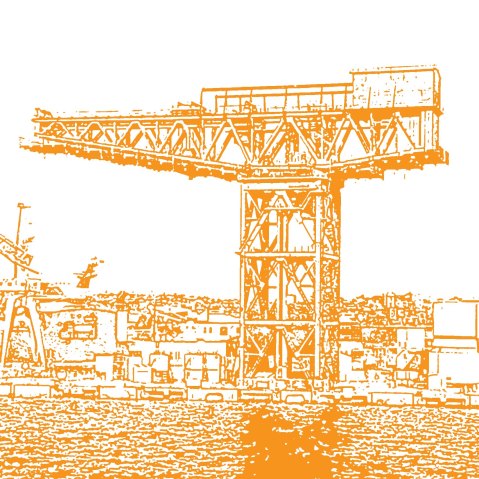
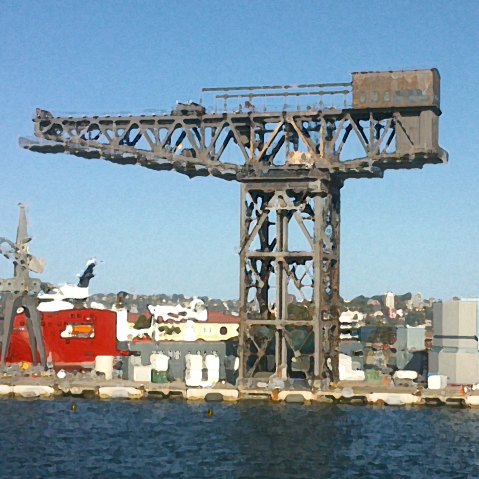
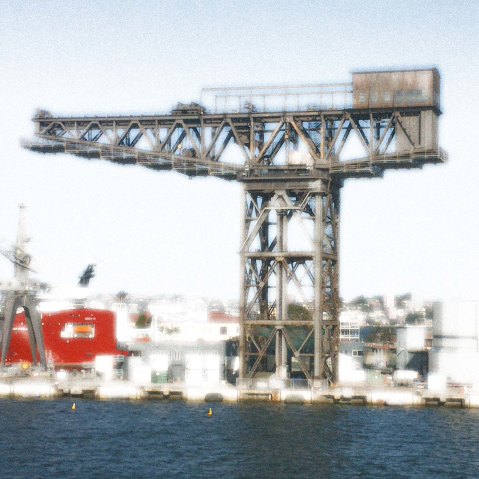
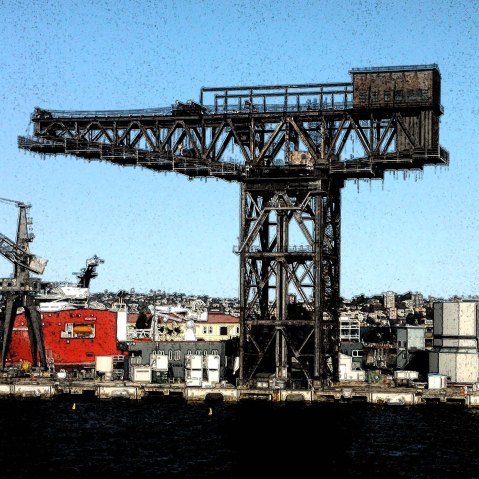
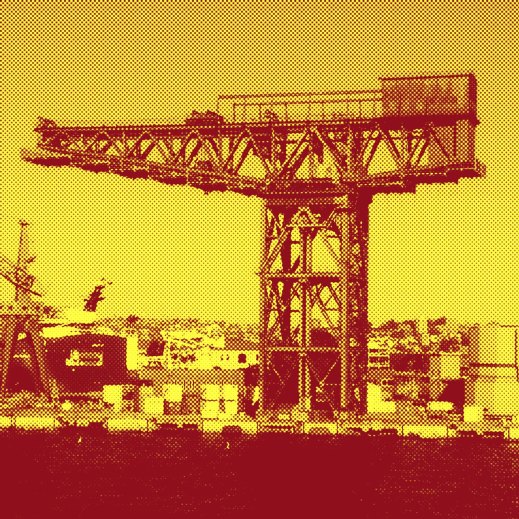
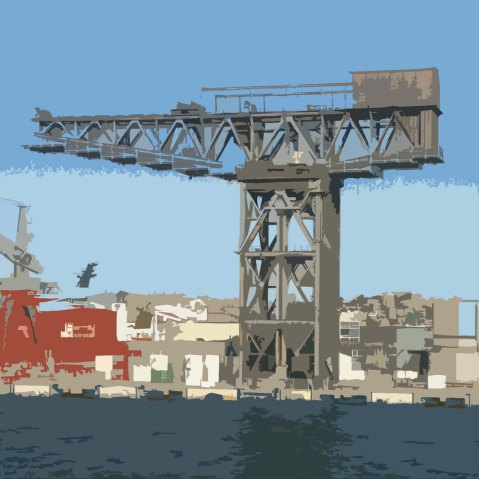

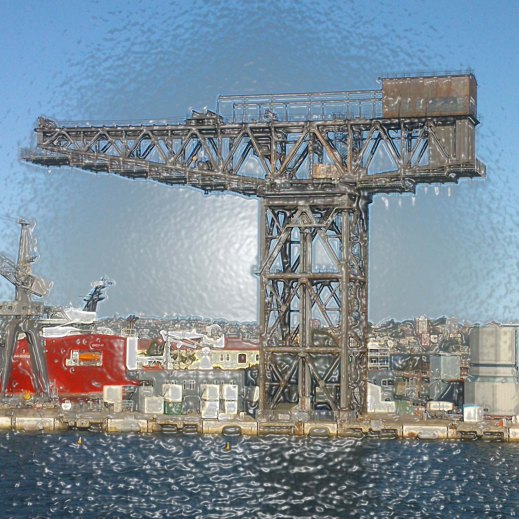
Going, going, … All images copyright 2013 Inheritance.
No.47 REDUCED TO RUBBLE

This is what happens when money is allowed to overrule everything else…
No.47 Connells Point Rd South Hurstville, the old doctor’s house, was reduced to a pile of rubble on Thursday 6th June… I know of a few people who will have broken hearts over this, myself included, my condolences go to them.
This is where I started my blog, because of this house. The previous long term owner had sold to a developer and been granted permission to build units on the site by Kogarah Council as part of the sale requirement. Unfortunately they had evaded heritage listing on the property over the years with the preferred intention of future capital return. Well they got their wish, but where the laws allow it, as in this case, property owners will always try to maximize the value of their investment, and by allowing the wholesale destruction of buildings such as this – true heritage assets – just because they have escaped listing, we set ourselves on a path of total heritage desecration, a point from which there is no return.
The sad thing is that there was enough land at the rear of the house to excavate and build three or four units, and that, combined with the house in its current form or redesigning as twin lodgings or a doctor’s surgery would have netted the owner a not unhealthy result financially. There was room for compromise.
Mention must be made of the concerted effort by a small group of residents who tried against the odds to save this house; Robyn, Leesha, Peter, Jane and family. Kogarah council turned a blind eye to its own local heritage and offered no support – I can recall a certain councillor, now local MP, who sniped at a campaigner something along the lines of “do you own the house? If not then why do you care?”… This political ignorance is why we are losing buildings such as this. David McCowen of Fairfax Media who was a local reporter at the time helped cover the story to a detailed level and thanks must go to him and the Leader.
It was noted by passers-by that trees were supposed to be retained, but have all been removed. Also, the stunning art deco lead light motif windows were not even removed from the house to be saved, apparently due to the costs of removal vs resale. Despite the bulldozer making light work of it, the quality of the workmanship of the building and its materials was evident.
Enlarge the image below and take a minute to reflect on how beautiful and perfectly proportioned this house was. The facade with its three coloured arches, the texture and glazing of the brickwork, the three window frames above, the generous eaves; there’s a hint of classicism to it that works so well… there’s something very European about it.
“An imposing interwar Art Deco style residence with a large front entrance consisting of three moulded and rendered archways and with art deco leadlight panelling throughout”- Musescape study
This was a purpose designed doctor’s house and surgery, in the Art Deco style, built 1929-1933 by the young Dr Frank James Howell with his parents, Norman and Louisa Howell on a plot of land from the railway estate period of Hurstville, where land was being opened up along the Illawarra line. It is futile now to go over the blame game, but I can recall Kogarah Council at the time claiming the house was not located in an area of heritage value. One walk up and down the surrounding streets outweighs that theory. If this is not a heritage-rich precinct I don’t know what is… I took a quick stroll and have attached a gallery of houses all within a five or ten minute walk of No.47; many are older than this house in vintage, but not as rare. Unfortunately this great Art Deco masterpiece will no longer be part of that streetscape.
For the original post, click here.
Historical notes by Leesha Payor and Jane Walther (illustrating the local significance of the home and why it should’ve been heritage listed)…
- Part of the Railway Estate, a speculative subdivision of the Australian Mutual Investment & Building Company Ltd. 254 allotments were offered for auction on the public holiday of the Prince of Wales birthday – Tuesday 9th November 1996, just two years after the Illawarra Railway had opened. [ZSP H10/245] (NSW State Heritage Inventory Form – C Betteridge, J. Matthias, L. Murray – 1999)
- The young Dr Frank James Howell with his parents, Norman and Louisa Howell, built their family home from 1929-1933-as a purpose built residence and combined doctor’s surgery.
- Dr Howells’ grandfather John Howell left behind his wife, eldest son and two daughters in Lancashire, and with his son Norman came to Australia in search of employment in 1884. It was almost a decade later before the family could reunite in 1893. Norman Howell gained employment with NSW Railways at the Everleigh branch, where he remained until his retirement in 1929 as ‘Principal Bookkeeper of the Locomotive Branch’.
- Norman Howell married Louisa Norton in 1900, whose ancestry can be traced almost exclusively to convict beginnings, as early as the Second Fleet. Louisa’s family lived in the Canterbury area and the Howell’s two sons were born in Haldon Street Lakemba, Frank James in 1901 and Edwin John in 1910.
- Frank Howell attended the Burwood Superior School and obtained a scholarship to Sydney Boys High School in 1915, allowing him free education and textbooks for 3 years. He completed a degree in Medicine (Master of Surgery) at Sydney University in 1924.
- Dr Howell’s university classmate was Dr John Saxon Crakanthorp, whose 1929 purpose built two-storey home and surgery in the ‘Tudor’ style, at 14 MacMahon Street, Hurstville, was listed as a Schedule 2 Heritage Item in Hurstville Local Environmental Plan 1994. Purchased by Hurstville City Council in 1978, this landmark property re-opened in 2004 as Hurstville City’s Museum and Gallery.
- After graduating, Dr Howell worked for another doctor in the small town of Kurri Kurri, NSW, before starting his own practice in South Hurstville. Set amongst older houses, he bought the remaining vacant allotments upon the highest end of a ridge, 47-49 Connells Point Road, in 1929 from Rosa Trickett. With his parents and brother Edwin, he rented the house opposite at number 24, all leaving to enter their new family home when it was completed in 1933.
- Living alongside their own surgery enabled a doctor to provide after-hours emergency care to patients and the community. Set among older single storey houses, this house was built to mould sympathetically onto the hillside rather than gouge it out. To maintain the streetscape, the building is sited on the two levels of the blocks, only the front half being of two storeys. Part of the setting, was the creation of a public park, to the west side of the house; the building is entirely visible and integrated with both the public park and the pedestrian thoroughfare to access Derwent Street. The private home entrance is accessed from the pedestrian stairs at the side, or from Derwent Street.
- Left to care for his mother in their home after his father’s death in 1946, Dr Howell employed a cook and a housekeeper during the day while he was working. His brother Edwin married in 1949 and with his own family, continued to live with them to care for their mother in the evenings. In a time before locums or medical centres, General Practice was a demanding occupation. The family recall the phone ringing almost every night as patients sought attention and the surgery hours extended very late. Whist visiting a patient on the 22nd December 1956, Dr Howell suffered a massive heart attack, and unable to receive emergency aid, he died that day aged 58 years.
- Dr Howell worked as a General Practitioner for almost 30 years and was well respected; his funeral cortege proceeded down King Georges Road with small groups assembled on the side of the road to pay their respects. Other doctors in the area were few at the time; they included Dr Lee, Dr Crakanthorp and Dr Jackson. For the home and surgery to continue its service to the community, the Howell family sold their estate to Dr Pearson and his young family in 1959.
- Dr Barry Pearson was born in 1924 and graduated from Sydney University, M.B. B.S. in 1952. After opening his practise, he became a Hurstville Rotarian in 1960 and as their President, he engaged their support to commence the first Meals on Wheels Service for the area, by raising the initial funding to build a kitchen within Hurstville Community Hospital. Now called Hurstville Community Food Services, this community-based operation covers the City of Hurstville and the City of Kogarah; opened on 4th July 1967, 30 years later it served its one-millionth meal. Dr Pearson continued his active interest, both as Patron of the service he founded and as a regular volunteer. In 2006 Dr Pearson received an OAM, “for service to medicine as a general practitioner and to the community of Hurstville through aged care and service organisations.”
- Dr Barry Pearson OAM raised his children and maintained his practise for 20 years at 47 Connells Point Road until forced sale in 1982. The home and surgery was purchased and was used as a private residence for the past 30 years. There have only been 3 owners in its 83 years.
FOR SALE: A FEDERATION DIAMOND IN THE ROUGH

There is a renowned heritage street in Bexley that holds many a fine residence… Victorian, Federation, Bungalow, Art Deco… a walk down Dunmore Street North is like stepping back in time. Bookended by classic main street shopfronts and churches up on Forest Road, down to the state heritage listed Seaforth Park at the lower end, the street and suburb it occupies are home to many splendid gardens as well, some immaculately pruned and tended, and some, let’s just say, a little rougher around the edges.
Look carefully at the jungle growing on a block at 26 Dunmore Street North. Between the trees and shadows you will find a hidden Federation masterpiece, waiting to be uncovered and have new life breathed back into it, like a dusty Rembrandt sitting unknown at the back of a museum storeroom. This house is ripe for renovation, and in the afternoon light stunning period features still shine and give away a hint of the extravagance waiting to be uncovered and brought back to their timeless beauty by someone with a keen eye for what constitutes smart ‘forward thinking’ real estate value and a worthy investment. Bullseye leadlight windows, turquoise Art Nouveau tiling, patterned brick archways, delicate balcony timber fretwork, this house has all the wonderful features of the period.
Federation homes were exceptional in their level of embellishment, quality of workmanship and attention to detail, as well as giving us our own national style of architecture; those on corner blocks were even more impressive as they were always built to suit the site, facing two directions to greet the outside world and often taking advantage of winter sun flooding through bay windows, while maintaining an air of coolness in summer with deep and richly decorated porches.
That’s the end of my real estate agent spiel; it may not be along the lines the agents are pushing this time, considering the land size of 1,176sqm lends itself to perhaps something of a different scale. As quoted from the Domain website by agents Raine and Horne:
“Property Features:
*Original 4 bedroom federation full brick home in need of TLC
*Potential for Developement (STCA)
*Situated on a corner position
*2 Driveways
*Level clear block of land
*Approx 23.4 metre frontage X Approx 50.2 length
*Family orientated area, with excellent schools, transportation, and ease of access to Bexley shopping village.
Will be sold at Auction!!”
A few years ago a corner parcel came up for sale with a similar unloved Federation home at the bottom of the street. What happened next was a little strange. Residents at the time were concerned for the streetscape and lobbied for the new owners to retain the house. It didn’t stand for long, and was levelled and replaced by a large gaudy modern home ‘in the Federation style’, complete with sandstone foundations and stained glass. Why anyone would demolish a Federation house to build a Faux-Federation I don’t know but the trend has spread next door to where an almost identical building has sprung up.
Don’t let the developers get this one. The street is too picturesque and historically revealing to be ruined by duplexes. Any astute heritage buyers, this is the one for you. For sale by auction, Saturday 1st June. Be quick…
Click on images below to enlarge gallery…
FOREST ROAD, HURSTVILLE – A MOMENT IN TIME

The suburb of Hurstville in southern Sydney has long been a place of change. From transport hub to shopping megalopolis to high rise residential, the city hasn’t been spared the throng of development engulfing many centres around metropolitan Sydney. But Forest Road, the busy main thoroughfare lined with Asian eateries and grocery markets, still retains glimpses of architectural charm.
I enjoy a stroll along the bustling strip, now clearly influenced by a generation of Chinese migrants. Here you will stumble across butchers selling budget chops, rock star Vietnamese bakeries peddling pork rolls to the masses, Bok choy and Choy sum falling out of little boxes outside grocery stores, golden roast duck hanging gloriously from shopfront windows, noodle and dumpling bars exuding sweet aromas. And as its backdrop, a charming mixmatch of Victorian and Federation style shopfronts and art deco facades, even an early underground shopping arcade linking Forest Road to nearby Westfields, rumoured to be the first outside the Sydney CBD.
The place is a hive of activity, a successful working class migrant story, and it oozes an air of Oriental resourcefulness and prosperity. It’s good to see the Chinese community interact on Forest Road, the way they meet, the way they banter and communicate with one another. Elders are respected and their company is relished. You see it anywhere people of Asian backgrounds congregate. I believe westerners can learn from this sense of social connectivity on show.
But drastic change is once again in the air. A backflipping council, who previously claimed they would keep the CBD residential-free, now has big publicized development plans on the agenda. This is already taking shape along the northern stretch of Forest Road, just along from that massive former Amcor factory development, at 127-141 Forest Road, where a gaping hole has recently appeared and swallowed up a row of little shops and restaurants.
One of these shops was the Chinese grocer occupying Advance House, formerly known as Swans Hardware, a distinctive Art Deco warehouse that has been on the redevelopment radar for some time. There was a legal stoush between architect-developer Nick Katris (who also happens to be a Kogarah councillor) and Hurstville Council, which ended up in the Land and Environment Court. Katris and Associates lodged the original DA with no intention of keeping Advance House in any shape or form, but met an obstacle when Hurstville council’s heritage advisor, Graham Brooks, nominated retention of the Art Deco facade, being a listed item under Hurstville’s LEP. According to the court judgment, ‘Mr Brooks considered that there was an inherent conflict between the heritage listing in LEP 1994 and the site specific controls in the DCP, which permit large scale redevelopment that may overwhelm the retained element.’
At least they have left the façade for posterity, although far from acceptable, it’s better than nothing. It is only a wall after all, is that any substitute for a true heritage building?

Katris and Associates approved development. The heritage facade is a little overwhelmed to say the least.
Further along, opposite the railway entrance sits the Stokland (former Fosseys) building, a landmark example of an early department store, and quite an elegant example of its type. This council-owned building is now for sale, under a profit taking scheme to bulldoze and replace it with a small park standing over several new levels of underground shopping (that must be a first for modern-day planners; you can have a park, but it needs to make money, there needs to be a shopping centre beneath it!). The existing historic arcade is also at risk.

Stockland, former Woolworths, Fosseys art deco store, 1951. To be sold and demolished by council 2013.
Hurstville Council, under pressure from the NSW planning department, now appears intent on bulldozing much more of Hurstville’s historic main street. Now it’s been revealed that village centres Riverwood, Peakhurst, and Penshurst won’t be spared either under new zonings set by Minister Hazzard, despite Hurstville Council trying to ‘funnel’ high rise into the CBD. How much will survive now that high rise development will be allowed to encroach into Forest Road and other centres. Many of these buildings are over 100 years old, in essence, an ‘old town’ streetscape that should be retained and protected rather than turned into glass and concrete high-rise.
There is nothing more soulless than new glass shopfronts supporting multi-storey units. Many of us prefer the rambling, human scaled, colourful, sometimes crumbling shopfronts of a Hong Kong style market, where street life abounds and takes on a meaning of its own. This won’t be the case with new mega-development from architect firms such as Katris and Associates, swallowing up any heritage, any vibrant colour that now exists on the Forest Road strip; heritage that has evolved over time to take on new generations, and suit their needs, and provide all that is required for a healthy shopping precinct to exist into the future.
HISTORIC WOODSTOCK SERVICE WING DEMOLISHED

It has been brought to our attention that a service wing of the Victorian mansion Woodstock, owned by Burwood council, is being demolished to make way for a new hall complex.
The service wing, dating from 1894, and adjoining toilet block, from 1981, are to make way for the 1.6 million dollar project commencing immediately, due for completion in late 2013, to be built by Rapid Developments. Woodstock itself is listed as a state-significant heritage asset, and known as the pride of Burwood, which makes it quite surprising that the attached period services wing can be bulldozed with little or no public consultation, and what seems total disregard for the completeness of architecture… The loss of this wing is subtractive to the overall Victorian era build of Woodstock, and diminishes the heritage feel of the structure as a whole. Washrooms and laundries were almost always placed in separate wings and although it was added slightly after the main 1873 building it does match in style and can be seen as integral to the structure.
The new hall has its own architectural style and I will let you be the judge of whether it befits a house of this historical stature or not. Certainly it will add to the amenity of the building which accommodates over 40 community groups including arts and fitness users and radio station 2RDJ-FM. However what is concerning here is the partial demolition of an important heritage building, and the way an ultra-modern hall can be lumped on to a Victorian mansion with what seems to be “heritage gay abandon”, completely convening the rules for state-significant listed properties. The new hall will crowd Woodstock and block one whole side from view.
We asked for an Interim heritage Order to be placed on the demolition, but were denied by the NSW Heritage Branch due to the following (hardly satisfying) reasons:
“It is considered that an IHO for the site is not warranted; the reasons for this decision are outlined below:
· This matter has previously been assessed by the Heritage Branch and there has been no change in the circumstances of the approval or heritage assessment of the property;
· The heritage impacts of the proposal were considered in the DA process; and
· The main part of Woodstock is to be retained.”
A Brief History of “Woodstock” – 22 Church Street, Burwood NSW 2134
Mr. Edwin Penfold, one of Australia’s largest tobacco manufacturers, built Woodstock in 1873.
In 1914, Woodstock was sold to Mr. Keep, who renamed the mansion “Broughton”. The Keep family resided there until 1941.
The property was then transferred to Burwood Council for a short time until the Commonwealth Government acquired it in 1942 for use as Army divisional headquarters. After the war, the property remained vacant until 1949 when it was used as a migrant hostel until 1974.
In 1976, Sir William McMahon arranged a long lease for Burwood Council on the property and the council restored, renovated and converted it to the community centre it is today. It was officially opened by the Governor General, Sir Zelman Cowan on November 11, 1979.
Before his retirement from politics, McMahon the former Prime Minister and then Federal Member for Lowe, negotiated a sale, whereby the Council bought the property from the Commonwealth Government in April 1982 for $40,000.
The 100 square building set in several acres of land is home to at least 40 organisations and community groups. In a year, more than 80,000 people use its multitude of facilities. The building also houses the studios and offices of radio station 2RDJ-FM.
The name “Woodstock” was derived from Woodstock, Oxfordshire, England.
CLOSING NIGHT FOR THE KOGARAH MECCA

This gallery contains 10 photos.
On Wednesday night, 27 February 2013, a small group of dedicated locals and heritage activists gathered by candlelight opposite the old Mecca theatre site at Kogarah. We shared Fantales and choc tops, listened to tones of the original Christie 2/7 Victory theatre organ “broadcasting from the wilds of Kogarah” and showed poster billboards of The […]







































































































